Fait, Fiction et Propagande
En 1998, alors que Naomi Kramer cherchait sur Internet des informations sur la tempête de verglas à Montréal (Québec), elle a été choquée de trouver dans la recherche Google le site Internet néo-nazi Stormfront. Consternée par cette découverte, elle ne pouvait pas rester les bras croisés alors que des mensonges antisémites, préjudiciables et discriminatoires déployaient leurs ailes trompeuses dans le cyberespace. cette présentation, achevée en 1999, est le fruit d'un effort visant à informer le public des dangers de la haine et de la propagande en ligne.
Slide Notes
Slide 1
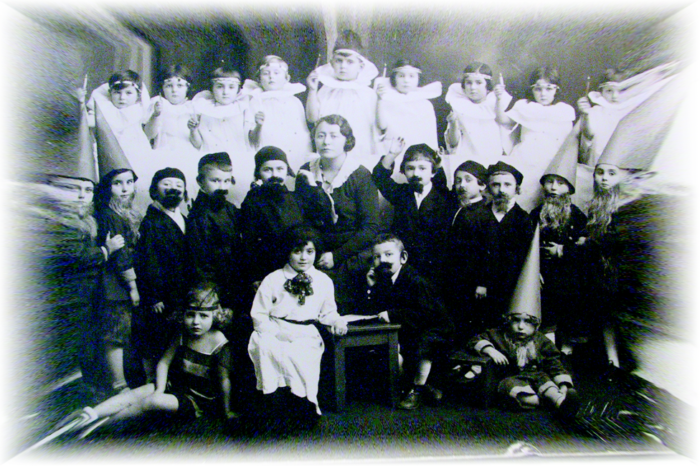
Fact, Fiction, Propaganda
The propaganda images in slide one were all retrieved from the Internet. Sympathy for the Devil by the Rolling Stones is the background music which accompanies the propaganda posters. This song was chosen to enable the facilitator to draw a parallel between the clues in the song regarding the identity of the narrator (Satan) and the clues with which contemporary propaganda is invariably infused. Examples of such clues on “Hate Sites” include the use of the Gothic font, the term Aryan, references to “us” and “them,” and terms such as “white supremacy.” The music used on the site is often an indicator of the type of emotion that the site is intended to evoke.
The rapid succession of the twenty-one images is meant to capture student interest. The final photograph portrays Jewish children in pre-war Europe. They are celebrating the festival of Purim. This photograph will allow the instructor to segue into a discussion as to how Jewish children had little chance of surviving the Holocaust. The image underscores the effectiveness and inherent danger in Nazi propaganda and propaganda in general.
Photo Source: Montreal Holocaust Memorial Centre, Archives
The discussion should include an analysis of the overlap between advertising and propaganda.
Children and the Holocaust
Children were especially vulnerable victims of the Nazis. It is estimated that over one million children were murdered under Nazi rule in Germany and occupied Europe.
In the ghettos, many died from lack of food, clothing, and shelter. The Nazis considered many ghetto children unproductive. They were generally not used for forced labor, which increased their chances for early deportation to concentration camps and extermination camps. Jewish children were among the first victims when the Germans and their collaborators sought to destroy a Jewish community by shooting the inhabitants or deporting them to a killing centre.
Following selection at Auschwitz and other camps, the majority of children were sent straight to the gas chambers. A number of children in the camps, especially twins, were used in Nazi medical experiments. SS and police forces in Poland and the Soviet Union also shot children. Jewish council (Judenrat) chairmen were forced to make the painful and controversial decision whether to fill quotas of children for deportation. Janusz Korczak, director of an orphanage in the Warsaw ghetto, refused to abandon the children chosen for deportation. He accompanied them on the transport to Treblinka.
In spite of overwhelming victimization at the hands of the Nazis, many children discovered ways to survive. Many children were involved in smuggling food into the ghettos. A number of children in youth movements were active in resistance; many participated in escapes to partisan family camps. Some non-Jews provided hiding places for Jewish children ands sometimes, as in the case of Anne Frank, for other family members as well.
Kindertransport (children’s transport) was the informal name of a rescue effort, which brought thousands of refugee Jewish children to Great Britain from Nazi Germany and German-occupied territories between 1938 and 1940. In France, almost the entire Protestant population of Le Chambon-sur-Lignon hid Jewish children.
In the aftermath of the Holocaust, refugees searched throughout Europe for missing children. Thousands of orphaned children were in displaced persons camps. Many fled Eastern Europe as part of the mass exodus (Brihah) to the Allied zones of occupation, en route to the Yishuv (the Jewish settlement in Palestine). Through Youth Aliyah (Youth Immigration), thousands migrated to the Yishuv, and then to the state of Israel after it was established in 1948.
Copyright © United States Holocaust Memorial Museum, Washington, D.C.
Slide 2
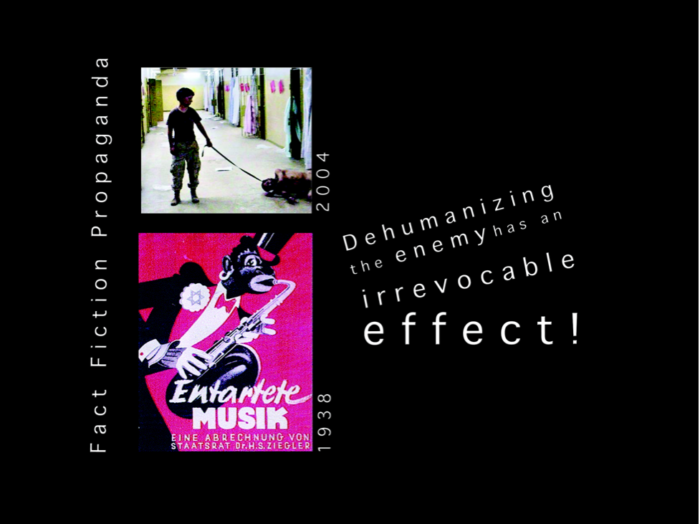
Moral Responsibility
Today, contemporary controversies engender passionate appeals to history. The Holocaust stands as a paradigm of the destructive powers of prejudice and discrimination. If moral behaviour is taught and not an innate quality of human existence, there is hope for change and for a future that ensures all people may live by their beliefs with pride rather than be forced to conceal them through fear of discrimination and death. Everyone has the capacity to give freedom to all of humankind if they care enough and assume this moral responsibility.
We must continue to break the conspiracy of silence that characterized the world’s reaction to the Jewish plight sixty years ago. We must be vigilant in our teaching of and fight against contemporary atrocities occurring in Bosnia, Rwanda, Sri Lanka, Zaire, Darfur, and Sierra Leone.
Memory without consequence is futile.
The Fallacy of Race and the Shoah
Socrates describes goodness in the Republic as that which every soul peruses as the end of all its activities, dimly perceiving its existence, perplexed, and unable to grasp its nature with the same clearness and assurance as in dealing with other things.
It is a consequence of this view that both the hero and the criminal act with the intention of serving their own welfare. The difference between the actions of the two is that one correctly sees that this welfare is dependant on moral behaviour. This is another way of saying that reality lies in perception. Thus we are able to see a strong connection thought and action. It follows that to understand action one must examine what value individuals see in their behaviour.
If we are to meet the future with the intent of effecting change in the “condition of man” we must do so with knowledge of the past.
Human rights are crucial to transmitting the value of acting in a morally responsible way. Rights involve responsibilities and duties toward the community as well as an obligation to respect the rights and freedoms of others.
A discussion of human rights should include freedom of thought, conscience, religion, opinion, and expression; freedom to join with others in peaceful assembly and association, for example in trade unions and the right to take part in one’s government, through elections and through equal access to employment in public service.
United Nations
http://www.ohchr.org/english/law/ccpr.htm
Civil and Political Rights. . . .all persons have the right to life liberty, and security of the person. No one may be held in slavery, punished in an inhuman or degrading way or tortured. Everyone should be equal before the law. No one may be arrested or exiled because of whim. Persons are entitled to a fair hearing if charged with a crime, and shall have the right to be presumed innocent until proven guilty. Everyone’s privacy, family home, and correspondence are to be protected against arbitrary interference. Persons who are persecuted have a right to seek asylum in another country. All persons have the right to a nationality. Everyone should be able to marry and found a family if they choose, and families are entitled to protection. All have the right to own property.
http://www.ohchr.org/english/law/cescr.htm
Economic, Social, and Cultural Rights. . . .include the right to work, to free choice of jobs, to just and favourable conditions of work and protection against unemployment. Every man or woman should be entitled to the same pay for the same work. Everyone has the right to rest and leisure. All have the right to an adequate standard of living-including adequate food, clothing, housing, medical, and social security. The family is entitled to the widest possible protection and assistance. Everyone has the right to education and the right to freely participate in the cultural life of the community.
Slide 3

The goal of this presentation is to teach students to be critical thinkers. This is accomplished through analyzing the relationship between fact, fiction and/or opinion, as well as propaganda. To be able to distinguish between these terms will provide students with the capacity to analyze information in both contemporary and historical settings. (Students will derive a better understanding from the presentation if they have had a preparatory session on the historical context and events of the Holocaust.)
We begin with a discussion of the concepts of “race” and racism, stereotype, prejudice, discrimination, and propaganda. Propaganda is first examined during the Nazi period in order to alert students to its appalling consequences, to illustrate the techniques of the propagandist, and to contextualize the historical origins of racist propaganda. The presentation concludes with an analysis (based on parallels and contrasts to earlier Nazi propaganda) of contemporary propaganda and racism on the Internet.
Determining the relationship between fact, fiction, and propaganda is a prerequisite to evaluating the credibility of information in any setting. To be able to distinguish between fact and fiction is to understand and recognize the manipulative techniques of the propagandist.
The Internet has become a forum for many groups (such as white supremacists, neo-Nazis, and other hate groups) to influence viewers by distorting fact and fiction, and playing on dormant fears and prejudices. On the Internet, where information is generally uncensored, the growth of the number of “hate sites” over the last few years has been rampant. The free flow of information on the Internet makes an analysis and discussion of contemporary propaganda and its methodology more important than ever.
The next five slides are examples of contemporary hate sites. In showing them,the teacher should draw attention to their widespread presence and easy accessibility on the Internet. The sites are also compared and contrasted for stylistic elements and contents. The purpose of these examples is to emphasize the contemporary setting and pervasiveness of propaganda, as well as the urgency with which such bigotry and prejudice must be addressed.
Music: Don’t Worry, Bob Marley and the Wailers
Slide 4
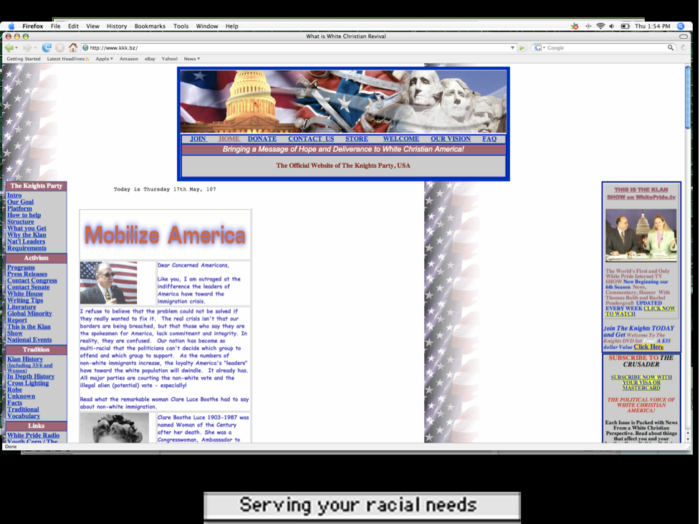
Ku Klux Klan
(The Alabama White Nights)
http://www.kukluxklan.net
This web site loads up while playing the well-known song, Riders on the Storm by the rock group, The Doors. The familiar and soothing melody is meant to put the viewer at ease with the overtly racist and hateful contents of the site. Note, however, that the music played here is not the original The Doors recording. A click of the mouse reveals the original version, and the differences are not difficult to spot. The significance of this particular song stems from the fact that members of the Ku Klux Klan were known as “Night Riders.” During their nightly excursions on horseback, Klan members would often lynch and beat non-whites, or their sympathizers. The burning cross became the symbol of the Ku Klux Klan and its white supremacist ideology.
The effect of playing this familiar melody and introducing The Doors music into the context of the site is manipulative. Many sites today feature music and film footage, a reflection of the multimedia approach that makes these sites more interesting and attractive.
The bottom of the frame features moving ticker tape that creates a sense of urgency and the impression of being up to date. The text reads “Serving your racial needs,” inferring the Ku Klux Klan is a service organization. At the top, the viewer is encouraged to participate in a boycott against the well-known ice cream chain “Ben and Jerry’s.” The emphasis here, as on many such sites, is on exclusion and “us and them.”
Slide 5

Hammer’s Hate Site Extravaganza
The aggressive symbolism and music of this site incites a sense of anger and need for action in the viewer. Ask students to identify the swastika and draw their attention to the colours used on the site. Distinguish between subliminal and overt messages.
Slide 6
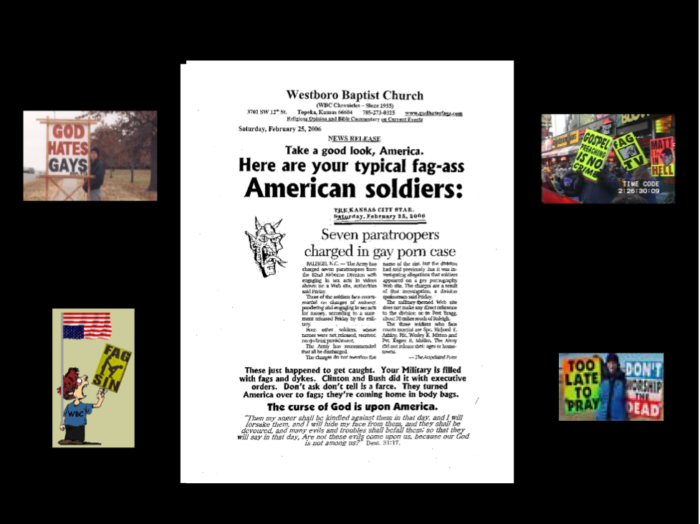
www.godhatesfags.com
http://www.frontpagemag.com/Articles/ReadArticle.asp?ID=21229
The “God Hates Fags” By Mark D. Tooley
Front Page Magazine.com | February 9, 2006
He started out by demonstrating at the funerals of AIDS victims. He demonstrated at the funeral of the young homosexual, Matthew Shepard, who was murdered in Wyoming. For reasons somehow relating to homosexuality, he demonstrated at the funerals of Frank Sinatra, Barry Goldwater, Ronald Reagan, William Rehnquist, and children’s program host Mr. Rogers. He warned Senator Pat Moynihan beforehand that he would be demonstrating at his funeral, too.
Now he is demonstrating at the funerals of U.S. military personnel killed in Iraq to celebrate the deaths of those killed while defending a “fag” nation. He also demonstrated at Coretta Scott King’s funeral, not for reasons relating to race, but because she agitated on behalf of “queers.”
In response, several states are now considering legislation banning demonstrations at funerals. He is their main and probably only target.
He is Pastor Fred Phelps of the Westboro Baptist Church in Topeka, Kansas. And his “God Hates Fags” theme has earned him an unending stream of media attention over the last 15 years.
Media have commonly described Phelps as a “Baptist pastor” and “anti-gay activist,” with the implication that he was simply a more aggressive component of the Religious Right. Nation magazine included Phelps in a profile about the “The Radical Right After 9/11.”
Phelps celebrated the 9/11 attacks and the more recent al-Qaeda strikes in London as the just recompense of Western decadence. He supported Saddam Hussein and has been appreciative to Fidel Castro. Phelps is probably more appropriately described in psychiatric than political terms. But his political roots are in the Democratic Party, having run for office in Kansas five times, and actively supported Al Gore in 1988 and 1992 before turning against him.
More careful media coverage acknowledges that Phelps’ ostensibly Baptist church is “unaffiliated” and comprised of only his family members, whose compound of houses is assembled around the church and its swimming pool used for baptisms.
Phelps, now age 76, has demonstrated outside the Bush Ranch in Crawford, Texas. He has demonstrated against conservative religious activists James Dobson, Jerry Falwell, and Pat Robertson. He has demonstrated against the Southern Baptist Convention. His targets span the full political and theological spectrum. Anyone who does not share his insistence that God reserves a special hatred for homosexuals is worthy of the Phelps treatment.
Such a calling in life might be lonely. But Phelps himself is aggressively patriarchal, with 13 children and at least 50 grandchildren. At least 10 of his offspring are lawyers, like him (though he has been disbarred). Legal challenges to his campaigns of hate are met with aggressive and litigious responses, which often earn the Phelps’ rich court-awarded penalties from their targets. The Phelps family is quite insistent on their First Amendment rights. Thanks to their legal prowess, Westboro Church does not accept contributions from outsiders. They are not needed.
The white-haired, Mississippi born-preacher often rants and shakes before hanging up on reporters or pushing away their microphones. With authentically hateful rhetoric, large brood and shag-carpeted Kansas church, he is almost the perfect embodiment of what some isolated Manhattanites in their most fevered dreams might imagine a red-state zealot to be. But Phelps, with dreadful consistency, exceeds even the worst stereotype.
Phelps’ story merits a file cabinet full of psychological analysis. According to the Southern Poverty Law Center, which monitors “hate groups,” among which Phelps proudly numbers, he was ordained at age 17. He rejected his mild Methodist upbringing, cut-off his family, and dropped out of both West Point and Bob Jones University. Time magazine profiled him only a few years later because of his street ministry against sexual vice in California. Phelps married young and moved to Topeka to pastor a Baptist congregation, where his violent behavior ended his pastorate. So he founded Westboro Baptist. But that congregation quickly melted away and Phelps resorted to door-to-door sales work.
After fathering his 13 children, Phelps became a lawyer and specialized in nuisance law suits. He also compelled his children to sell candy door to door every day to fund the church and the family, which are basically interchangeable. The Kansas Supreme Court eventually disbarred Phelps because of “little regard for the ethics of his profession.”
But in the 1980’s Phelps won several civil rights-related cases, earning him three awards from civil rights groups, including a local chapter of the NAACP. He also supported the 1988 presidential bid of Al Gore, whose campaign used Phelps’ family office space. Son Fred Phelps Jr., who had hosted a fundraiser for Gore, attended the 1993 Clinton-Gore inaugural. When invited to the 1997 inaugural, the Phelps clan came to Washington, but this time to demonstrate against the Clinton-Gore administration for betraying them. The Phelps family would also demonstrate at the funeral of Gore’s father in 1998. In 1990, 1994, and 1998 Phelps ran for the Democratic nomination for governor of Kansas, getting 15 percent of the primary vote in his last try. In 1992, he ran for the Democratic nomination for U.S. Senate, getting nearly 31 percent of the primary vote. He also ran for mayor of Topeka in 1997.
In the early 1990s the Phelps clan began its picketing at the funerals of AIDS victims. Their protests at the 1998 funeral of Matthew Shepherd earned Phelps his first international notoriety. His website, www.GodHatesFags.com, also made a splash.
Phelps wrote Saddam Hussein in 1998, opposing U.S.-led sanctions against Iraq and offering to visit Baghdad. Saddam accepted the offer but must have been perplexed when the Phelps clan showed up in the streets of Baghdad with placards denouncing anal sex. Phelps has also commended the anti-homosexual policies of Fidel Castro, who declined Phelps’ offer to come to Havana.
After the 9/11 attacks, Phelps celebrated that God was rightly punishing America for not hating homosexuals. The subway attacks in London persuaded Phelps that Great Britain also was being justly damned. Sweden has likewise become a special target. The 2004 tsunami that killed hundreds of Swedish tourists was divine retribution, Phelps surmised, and he started up www.GodHatesSweden.com.
“WARNING!!! To God’s Elect: Leave Sweden NOW!!!,” the website warns about a country that Phelps perceives is especially permissive about homosexuality. Sweden’s monarch Carl XVI Gustaf is called the “King of Sodomite Whores.” Phelps’ Sweden-focus got him Swedish media attention and the threat of litigation from King Carl, which Phelps eagerly reported on his website.
Age is apparently catching up with Phelps, and he does not attend all of the demonstrations now. His children and grand-children fly around the country taking care of that. Several of Phelps’ children have turned against him, claiming physical abuse during their childhoods. But the rest of the offspring seem to have remained dutiful.
Phelps professes a unique form of Calvinism that insists on God’s “perfect hatred” for the unrighteous, among whom homosexuals are chief. It is a brand of Calvinism, not to speak of Christianity, that would be foreign to anyone outside of the Westboro Church compound.
At his funeral demonstrations, Phelps insists his targets are now justly in hell. “God is not mocked,” the old firebrand declares, himself now approaching the age when the warning might be instructive.
Music: Young Man, Village People
Slide 7
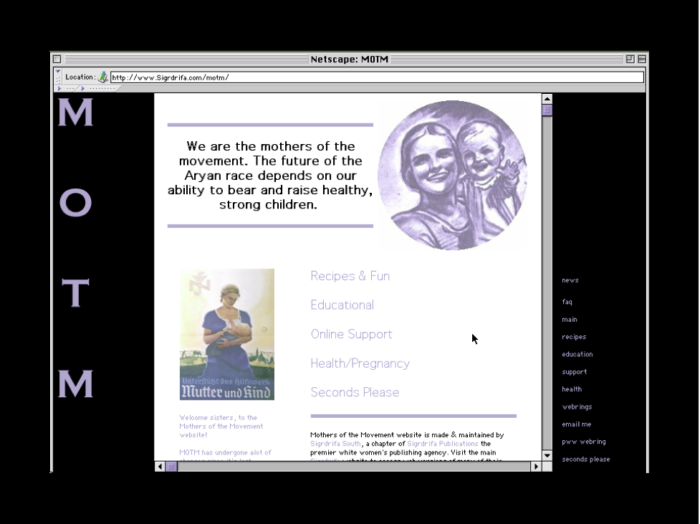
Mothers of the Movement
http://www.sigrdrifa.com/motm
This web site draws heavily on Nazi imagery and terminology. Both images of mother and child have been taken from Nazi propaganda material. Again, there is a strong emphasis on “race” and “race purity.” The site obviously targets white women, who are encouraged to bear and raise “healthy strong children” for the future of the “Aryan race.” The atmosphere of the site is serene and peaceful, contrasting starkly with the aggressiveness of the previous skinhead site. Women who view the site are meant to feel a sense of “racial” pride and self-worth that stems from being part of a greater cause. Links to such topics as “Recipes and Fun” and “Health/Pregnancy” enforce the stereotype (used often in Nazi propaganda) of women staying at home, bearing children, and taking care of the household.
Slide 8

Network 54
http://www.network.com/forum/message?forumid=241642&messageid=1061602282
Text on Site:
Racial Myths Message Board
Chat! Go back Post a Message
1. ITALIANS HAVE NEGROID AND MONGOLOID BLOOD – …. on Jun 9, 3:29 PM
Re: ITALIANS HAVE NEGROID AND MONGOLOID BLOOD – Your master on Jun 14, 8:10 AM
Does anyone remember Moi? I’m back! – briton on Jun 9, 2:03 PM
Yes, and nobody missed your mongrel Asiatic ass – A Real Briton on Jun 13, 1:39 PM
Compare and contrast the five web sites. There are some obvious differences as well as similarities. While the second uses very aggressive imagery, the third portrays a more peaceful and almost idyllic picture. In the first and second, there is an intentional and manipulative use of music. Certainly all five attempt to make the viewer feel a part of a greater and urgently growing cause.
An overriding factor of these sites, however, is that they appeal to something that all of their viewers have in common, that is, they aim to address members of the “white race,” while inciting fear and prejudice towards other so-called races. While we would all agree that these racist sites, it seems that we often run into difficulties while actually trying to define the word “race.” Indeed what is a race? And what is racism?
Slide 9
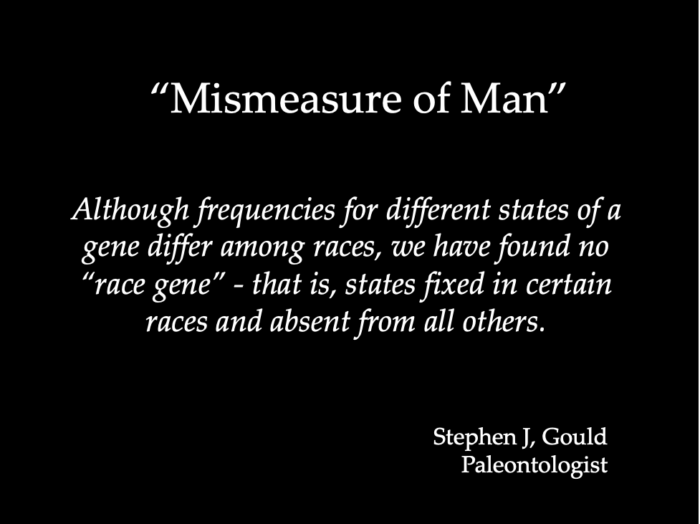
The quote, taken from The Mismeasure of Man, a book by the paleontologist Stephen Jay Gould, is meant to show that the concept of “race,” as we use it today, has in fact no scientific basis. In his book, he illustrates this point by using the following example. If the world’s population was almost entirely destroyed by a natural disaster, and there was only a small ethnic group left in a relatively limited geographical area, then all the genetic variations among people that we know today, would be preserved in the genes of this one group. This means that a small ethnic group of people possess the genetic material to eventually re-create the entire world’s population, regardless of skin color or any other outward appearances.
Another instructive example can be drawn from the Human Genome Project, an international scientific project whose aim is to map out the entire human genetic code. Drawing DNA from twenty-four individuals from various “racial” and ethnic backgrounds, scientists found that on average, their genetic codes varied only by 0.2 percent. The differences that were found among members of the same “racial group,” were often greater than between members of different “races.” J. Craig Center, head of Celera Genomics, a private company now involved in the project, commented: “What we’ve shown is that the concept of race has no scientific basis,” and “Race is a social, not a biological phenomenon.”
(“Do Races Differ? Not Really, Genes Show.” New York Times, 22 August 2000.)
Slide 10
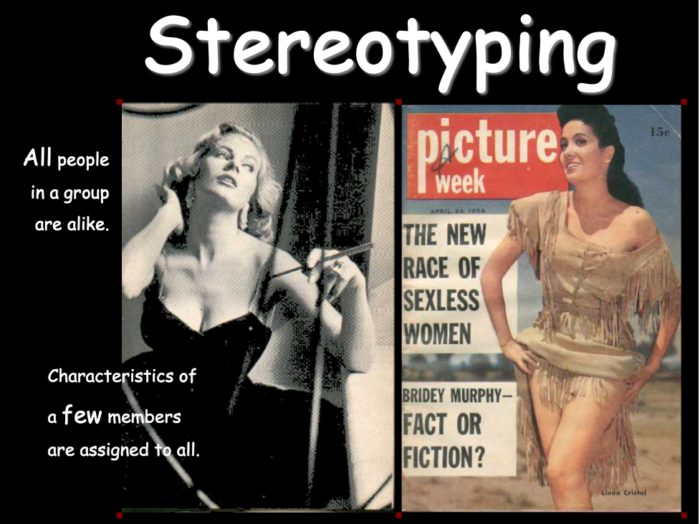
Stereotyping is a way of looking at individuals by assigning them with “group characteristics.” It is the first step in a process that can lead to prejudice, and eventually discrimination. In our example from a 1950’s newsmagazine (Picture Week, 14 April 1955), women have been equated to a “new race” of “sexless women” because they work outside the home.
Characteristics of a few members are assigned to all. The consequence is that all people in a group are seen to be alike. Like historians and philologists, anthropologists assumed the existence of an inherited substance that appears in one specific form and is characteristic of all persons belonging to the same “race.”
Racism is a visual ideology based on stereotypes. One of its main strengths is that stereotyping makes the abstract concrete, giving racism a clarity and simplicity essential to its success.
The role which the media plays in enforcing stereotypes should be discussed using gender, ethnicity, sexual orientation, and religion.
Music: A Natural Woman, Aretha Franklin
Slide 11
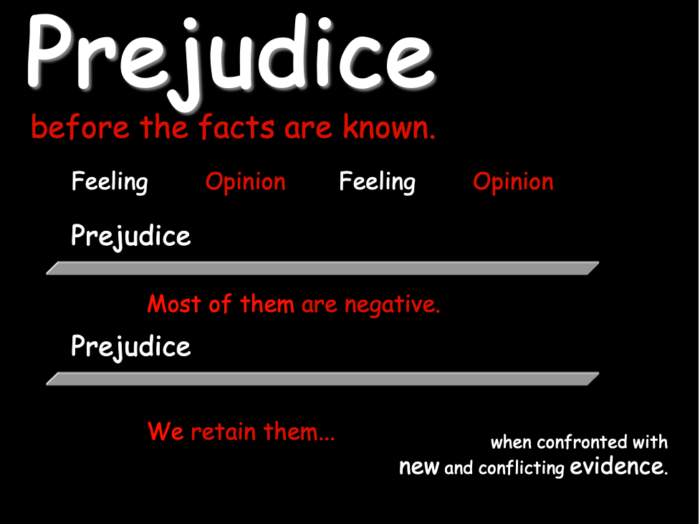
Prejudice: originally from the Latin, Praejudiciuma—premature or hasty judgement before consideration of the facts.
If stereotypes are not dispelled, prejudice is the next step in a process that may lead to discrimination. Prejudice, however, is more difficult to counteract. A prejudiced individual will cling to their beliefs, even in the light of new and conflicting evidence. Propaganda attempts to draw on latent stereotypes, emphasizing and exaggerating their negative traits, in order to channel fear and aggression towards a certain group.
Music: Congo Square, Sonny Landeri
Slide 12

Judaism
Like many other groups, Jews are often viewed stereotypically. Ask students whom they think corresponds to the “Jewish stereotype.” Inevitably, it is the religious Jew in the central picture. As the slide illustrates members of a religious/cultural group can in no way be identified by their physical appearance. What constitutes Jewish identity and Judaism? It is important to differentiate between the cultural, national, religious, and secular meanings of the term, as well as between Judaism and Zionism. Throughout history, a muddying of these terms has led to stereotyping, prejudice, and discrimination. Further on in the presentation we will see some of the manifestations of political, economic, and racial forms of antisemitism.
The child at the bottom left (Denise-Dora Gottfried from Paris) perished during the Holocaust. Denise-Dora lived at 29 rue de Turenne in the 3rd arr. She was deported on convoy 22 of 21 August 1942, with her mother, Chaya. Her father, Selig was deported on convoy 12. They were denied their right to live, because they were thought of as members of the so-called inferior “Jewish race.”
(Klarsfeld, Serge. French Children of the Holocaust – A Memorial. NY University Press, NY, 1996.)
Music: Shema Yisrael, Cantor Sydney Dworkin
The Shema is a declaration of faith, a pledge of allegiance to one God, an affirmation of Judaism.
The Shema is the first prayer Jewish children are taught to recite. The first line of the prayer is, “Hear O Israel, the Lord is our God the Lord is One.” It is from the Deuteronomy Chapter 6, Verse 4 .
The first paragraph of the Shema, emphasizes the study of Torah, the second paragraph emphasizes the observance of Torah.
The word “Torah” can mean different things in different contexts. In its most limited sense, “Torah refers to the Five Books of Moses: Genesis, Exodus, Leviticus, Numbers, and Deuteronomy. But the word “torah” can also be used to refer to the entire Jewish bible (the body of scripture known to non-Jews as the Old Testament and to Jews as the Tanakh or Written Torah), or in its broadest sense, to the whole body of Jewish law and teachings.
No matter what the interpretation of the teachings of the Torah it is what unites Jews across the all denominations, Reform, Reconstruction, Conservative, Orthodox, Modern Orthodox, and Hasidic.
Slide 13
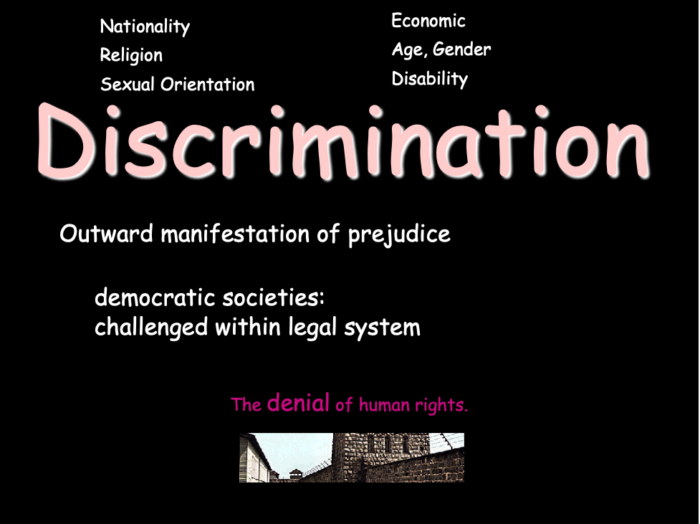
Discrimination is the last stage in the process that begins with simple stereotypes. It is the outward manifestation of prejudice, which can take a violent or non-violent form. Like stereotyping, discrimination is always directed at a member of a specific “group.” People are judged and classified according to economic background, ethnic and national origin, religion, sex, and many other attributes. The act of discrimination aims at excluding members of a group from the rest of society, emphasizing differences among people to create a sense of “us and them.”
In democratic societies there is usually legislation to protect people from discriminatory acts. In Canada, for example, we have the1982, “Canadian Charter of Rights and Freedom.” In democratic societies, we often tend to take for granted protection against discrimination. We have become accustomed to the standards of the “Universal Declaration of Human Rights” by the United Nations in 1948. But if we look at this definition of human rights in the context of the aftermath of the Holocaust and other Nazi atrocities, we are able to understand its significance. For most European countries before and especially during World War II and the Holocaust, discrimination was the norm, not the exception.
Not only was discrimination commonly accepted, it was actually legalized by the state apparatus. What was the outcome of “legal” and state-sanctioned discrimination in Germany?
The picture at the bottom of the slide shows the concentration camp Mauthausen, in Austria, in which almost one hundred and twenty thousand inmates are estimated to have perished. During the Holocaust, basic human rights were denied to many ethnic, national and political groups.
Music: Der Kaiser von Atlantis (“Emperor of Atlantis”), op. 49, Prolog, Viktor Ullmann, performed by Arbos
When Viktor Ullmann was murdered on 16 October 1944 at Auschwitz, the world lost a musical genius. A pupil of Arnold Schoenberg, Ullmann was an innovative, award winning composer and music journalist. In September 1942 Ullmann was interned at the Theresienstadt (or Terezin) concentration camp. The Nazis established Terezin as a phony model artistic ghetto. Artists, poets, and musicians populated the camp. Other Terezin composers included such prominent creative artists as Pavel Haas, Hans Krasa, and Gideon Klein (as well as the great Czech conductor Karel Ancerl). In reality Terezin was a holding station for internees bound for the death chambers of Auschwitz. During his two years at Terezin, Viktor Ullmann composed some twenty works.
The Emperor of Atlantis by Ullmann is a powerful, hard-hitting, satirical one-act chamber opera. The piece was almost ready for performance in Theresienstadt when SS members turned up at a final rehearsal and were outraged at what they heard. The opera was immediately banned and never performed in the camp. Despite being a so-called “model ghetto,” Theresienstadt was seen to have outlived its usefulness by the Nazis. The ghetto was shut down following a visit by the International Committee of the Red Cross in June 1944. In October almost all the composers and artists were sent to their deaths in Auschwitz. These included Ullmann and Kien: the libretto of Emperor Überall’s aria from The Emperor of Atlantis was written on the back of the transport lists of prisoners from Theresienstadt to Auschwitz.
Emperor of Atlantis—Brief Synopsis
The City of Atlantis is ruled by the Emperor Überall, who¾isolated in his gigantic palace–advocates total war against all. His is a city in which Life (represented by Harlequin) and Death (Tod) no longer hold any meaning.
The various characters react to the situation in which they find themselves–notably Death, who, when faced with the carnage of mechanized war, wishes to retire from his duties.
Despite the city of Atlantis being involved in fierce conflict under Überall’s orders, and thousands of people wrestling with death, no one is dying–Death has gone on strike. The Emperor is appalled.
Unable to die, two rival soldiers (one a girl) meet on the battlefield and fall in love, turning their backs on their military duties.
At a loss, the Emperor sees Death reflected in his mirror. Death will resume his duties if the Emperor agrees to die. The Emperor concedes to this the only hope for humanity.
Slide 14

Visualizing Memory….a last detail
This slide includes a seven-minute clip from the educational video, Visualizing Memory….a last detail. The video examines the way in which we understand moral responsibility and how we as a society transmit memory.
This specific excerpt defines the term Holocaust and refers to the Nazis “racial” policies including their own “Euthanasia Programme.”
This programme required that doctors and medical aides participate in the murder of some of their patients. The Nazis code name for the programme was T4 derived from the address in Berlin-Tiergartenstraße 4-where the programme had its headquarters. The victims were gassed, shot to death, or killed by lethal injections. The murders were euphemistically referred to as “disinfections.”
In the Nuremberg trial, the number of euthanasia victims was estimated at two hundred and seventy-five thousand. By 1 September 1941 more than seventy thousand had been “disinfected” according to T4 figures. Its victims included inmates of homes for the aged, homosexuals, the residents of welfare institutions, foreign workers, and concentration camp prisoners. The video distinguishes between traditional religiously based antisemitism and the Nazis racial antisemitism, which ultimately concluded that the only “solution” to the Jewish “problem” was to murder the Jews.
The term “Aryan” is introduced. The Nazis corrupted the original meaning, which referred to peoples speaking Indo-European languages. The Nazis used it to apply to a “stereotypical” ideal of those individuals from a Teutonic or Germanic background, usually those people who were blonde, blue-eyed, and tall.
Kleinmann Family Foundation, Montreal
Slide 15

This section examines the history of propaganda during the Nazi era.
Moral responsibility during the Nazi era and the need for assuming moral responsibility in contemporary society should be addressed at the beginning of this section. Few non-Jewish neighbours aided German Jews during the thirties and forties and indeed there was little resistance even within families to Nazi oppression.
It should be emphasized that apart from discussing moral issues, we all have an obligation to act morally and courageously.
Music: Jammin‘, Bob Marley and the Wailers
Slide 16

Winter Holidays
This video clip of the Voticky family on holiday will reinforce the notion that Jews were no different than their non-Jewish neighbours and were persecuted simply because they were born Jews.
The diverse population of European Jews should be raised. In 1939 Jews had lived in eastern Europe from the early centuries of the Common Era.
Between 1939 and 1945 the Nazis and their collaborators murdered two-thirds of the Jewish population of Europe.
Montreal Holocaust Memorial Centre, Archives
Slide 17
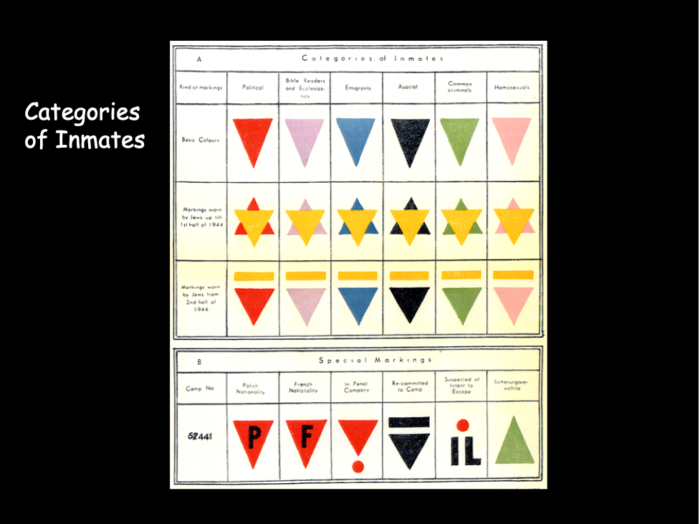
The stars, triangles, and markings in this poster are the symbols used by the Nazis to isolate and identify their victims. They are symbols of the legalized Nazi system of discrimination.
In the incorporated Polish territory of the Wartheland, Jews were forced to wear a yellow Star of David sewn to their clothing on the right side in front and back. After the Germans invaded the Soviet Union and Baltic States (Lithuania, Latvia, Estonia) in June 1941, they quickly introduced the star to mark Jewish businesses and, as in the Wartheland forced Jews to wear yellow stars in front and back.
On 19 September 1941, two years after the war had begun, a six-pointed yellow Star of David, to be worn on the left breast, became mandatory for all Jews above the age of six in the Reich. This yellow star had the word Jude with Hebraic looking calligraphy in black.
As slide eighteen illustrates, there were also special markings for prisoners in concentration camps. Victims were labelled and identified on arrival; this identification, in turn, contributed to their sense of isolation. Starting in 1933, inmates wore markings on their jackets and trousers consisting of the prisoner’s number and his or her colour coded inverted triangle. The most common were: red for political prisoners; green for professional criminals; black for “asocial” and/or Gypsies; purple for Jehovah’s Witnesses; blue for Spanish republicans; and pink for homosexuals. Jews wore an additional yellow triangle; the two overlapping triangles, with the yellow triangle beneath the other, formed a Star of David. Another group that was discriminated against were the so-called Afro-Germans. When non-Germans arrived in the camps during the war, they wore on their triangle the first letter of their country of origin to mark their nationality. Thus “I” stood for Italians, “F” for French, “B” for Belgian, “P” for Polish, “U” for Hungarian (Ungarn), and “T” for Czech (Tschechoslowake)
Following the peace of Versailles, Allied armies, and among them French colonial troops from Senegal, Morocco and other areas, occupied the German Rhineland. The children of these colonial soldiers and their German partners were referred to as “Rhineland Bastards” in the press of both the Weimar Republic and the Nazi regime. In Mein Kampf, Hitler declared that the Jews had “brought the Negroes into the Rhineland” with the “clear aim of ruining the hated white race by the necessarily resulting bastardization.”
(Burleigh, M; Wipperman, W. The Racial State. Germany 1933-1945. Cambridge University Press, Cambridge, 1991.)
On 13 April 1933, Göring requested the authorities in Düsseldorf, Cologne, Koblenz, and Aachen to provide accurate statistics concerning the “Rhineland Bastards.” Material relating to some 145 children was analyzed in accordance to pseudo-scientific racial criteria, with the conclusion that the “Rhineland Bastards” were inferior to their white contemporaries with regard to their physical and intellectual capacities and behaviour patterns. By 1937, the Gestapo formed a “Special Commission No. 3” which included representatives of public health authorities and academic experts. The latter helped locate the children, of which there were estimated to be between five and eight hundred, which were then compulsively sterilized. Plans to deport them were vetoed on the grounds of the possible impact upon world opinion.
Teacher Guide, USHMM, 1993.
Picture Source: The Chief Commission for the Investigation of Nazi Crimes in Poland. Jan Sehn, LL.D., and Wydawnictwo Prawnicze: Warsaw, 1957
Slide 18
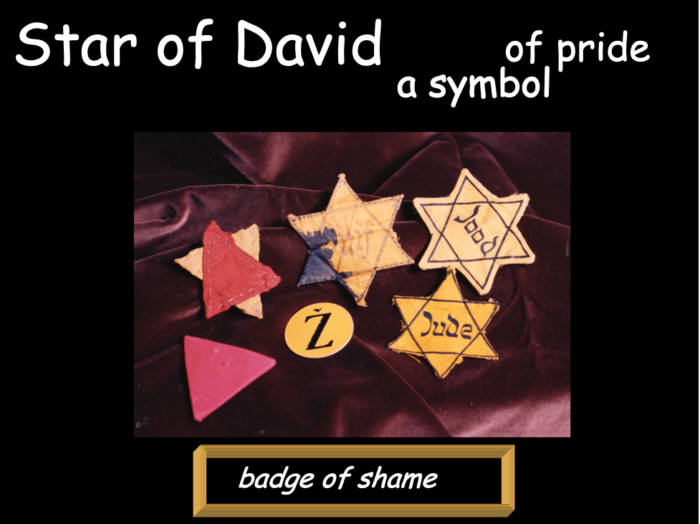
The Star of David was the distinguishing sign that Jews in Nazi Germany and Nazi occupied countries were compelled to wear.
In previous centuries, Jews had often been made to wear distinctive signs such as specifically shaped garments, shoes, and hats, in order to differentiate them from the rest of the population and to humiliate them.
In the eighth century Muslims declared that all dhimmi (protected people)—Christians, Jews, and Samaritans—must wear clothes that set them apart from Muslims.
In Christian countries distinctive signs were introduced on the basis of a canon issued by the Fourth Lateran Council in 1215, under Pope Innocent 111 (1198-1216) which stated that Jews of both sexes, in all Christian lands, shall be differentiated from the rest of the population by the quality of their garment. The decision of the Lateran Council, which was made to humiliate and shame Jews, was not uniformly applied across Europe.
In modern times, the Jewish badge was gradually abolished during the nineteenth century Emancipation. In November 1938 Reinhard Heydrich proposed to impose a distinctive mark on Jews at a meeting held in the wake of the Kristallnacht pogrom. In September of 1939, local German military and civilian authorities issued the first decrees ordering Jewish stores to be marked as such. In November 1939, the Jews of Lublin were ordered to wear a yellow badge on the left side of their breast, bearing the inscription Jude.
On November 23 a new declaration was issued to all Jews in the Generalgouvernment requiring them to wear, on the right sleeve of their Jacket or dress and on their overcoat, a white band at least four inches in width, with a blue Star of David inscribed on it. The Lublin Order was withdrawn and replaced with the white band.
In each country occupied by the Nazis, it was mandatory for Jews to wear a badge. The slide depicts several badges worn by Jews during the Shoah. The badges are from France (Juif), Holland (Jood), Germany (Jude), and Yugoslavia (Z). A political prisoner wore the red triangle and the red and yellow triangle indicated a Jewish political prisoner.
Slide 19
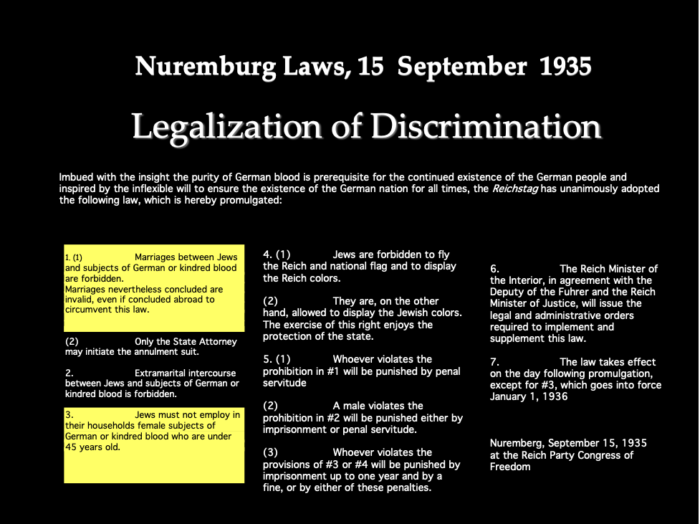
Not only did Nazi propaganda convince the German public that Jews were “genetically inferior,” but this concept was also incorporated into Germany’s legal system through the “Nuremberg Laws”: “Reichs Citizenship Law” (denied Jews German citizenship) and the “Law for the Protection of German Blood and German Honour,” both enacted in 1935.
These laws were instituted only two years after Hitler came to power. Among other restrictions, the “Law for the Protection of German Blood and German Honour” forbade marriages and extramarital relations between Jews and “subjects of German or kindred blood.” “Racial” discrimination, therefore, went beyond exclusionary measures within professional and public life. In order to maintain the “purity” of the “Aryan Race,” contacts and intercourse between Jews and non-Jews had to cease in every form. “Race” was seen as a primary biological feature of human beings, and in this sense, the Nazis regarded the “Jewish Race” as biologically inferior.
The third decree states that “Jews must not employ in their households female subjects of German or kindred blood who are under forty-five years old.” This decree enforced the widespread stereotype that Jews were lecherous and sexually perverted. Again, it was believed that such characteristics were “racially” based.
Although both laws were drafted rather quickly on Hitler’s orders, they also represented a long sought clarification of the legal status of Jews in Germany, as state and party antisemitic policy lacked unity in this respect. Especially in the course of anti-Jewish rioting in the summer of 1935, the party and the public were demanding that the Jewish question be explicitly defined and made public.
In addition to Jews, Roma and Sinti (Gypsies) as well as Afro-Germans were affected by this law.
Slide 20
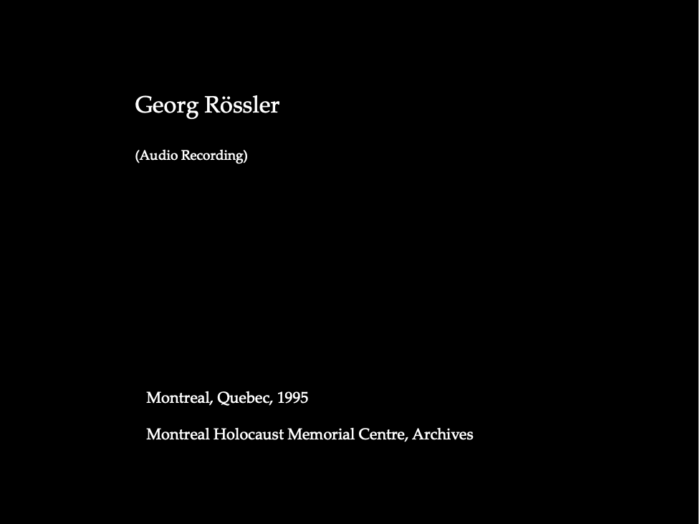
Geörg Rössler
Geörg Rössler, a Holocaust survivor grew up in Germany in the 1930s. Mr. Rössler describes how his father, a non-Jew, divorced his Jewish mother because life had become too restrictive for him-due in part to the Nuremberg Laws. He quotes the Gestapo’s declaration that it was “Jewish blood” which influenced his and his sister’s choice to live with their mother.
Montreal Holocaust Memorial Centre, Archives
Slide 21
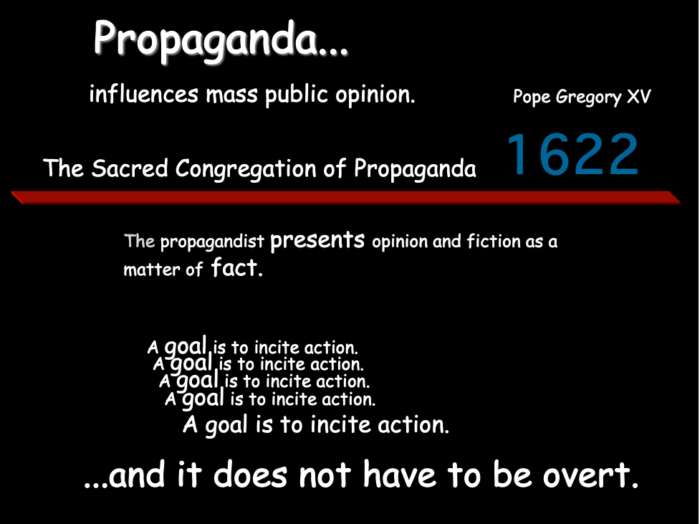
The term “propaganda” originates from the “Sacred Congregation of Propaganda” established by Pope Gregory XV to spread the faith of Catholicism. In this sense, “propaganda” originally meant to “propagate” or “disseminate” information. Speaking about propaganda today, we define it as a means of “influencing mass public opinion,” trying to gain support for a movement or a certain cause. Propaganda usually appeals to the emotions, not the intellect, as Hitler himself realized early on. This is the principal reason why the propagandist does not want careful scrutiny and criticism.
To whom should propaganda be addressed? (…) It must be addressed always and solely o the masses. (…) It must be directed toward the emotions, and only to a very limited extent toward the so-called intellect. (…) The receptive ability of the masses is very limited, their intelligence is small, their forgetfulness enormous. Therefore, all propaganda has to limit itself to a very few points and repeat them like slogans until even the very last man is able to understand what you want him to understand.
Adolf Hitler, Mein Kampf 1926.
Propaganda aims at inciting action (often by repeating a message numerous times). Often, this action is intended against a group or a cause.
A propagandist’s message can also be very subtle or even subliminal, making it more difficult to detect intentional distortions of fact and fiction. Subliminal propaganda may be less aggressive, but can be just as effective in the long term.
The following discussion deals with the question as to who wrote the Requiem. Facilitators should point out that the quest for truth and authenticity is still pursued some two hundred years after Mozart’s death.
http://www.openmozart.net/message.do?boardName=boardArchive&action=view&id=1195 (post not available anymore)
Re: Requiem—Mozart or Sussmayer?
Posted by Gary Smith on 14-Nov-1999
In Reply to: Requiem—Mozart or Sussmayer? posted by Alex Marciniak on 11-Nov-1999
Recall the line in a letter by his sister-in-law’ who was at his bed-side during his final days that “Mozart was instructing Sussmayer in how he was to finish the Requiem after his death: There is no doubt about it; Mozart knew he was going to die. Doesn’t it only seem logical that Mozart would at least provide Sussmayer with the themes for the remaining movements? Listen to the Benedictus, no one can convince me that is not a “Mozartean” theme. Of course we won’t find Mozart’s penmanship-he was too weak to write. rational, objective judgements based solely on just listening to this work. In summation, I think the skeletal framework of the Requiem is what Mozart had intended, beginning to end ,but the development of his ideas is where the work suffers. One can only imagine how glorious the Requiem would have been had Mozart lived long enough to complete it. Alex
Dear Alex,
There is probably no work of Mozart’s that has been more analyzed, discussed, argued over and written about than the Requiem K626. One of the major sub-sections has been the Benedictus as to whether Suusmayer is responsible for some, most or all of it. Another is whether given the skill (or lack thereof) of Sussmayer, others should attempt to compose “more worthy” music in order to properly honor Mozart.
Regarding who composed what, when the question was asked of him in 1799, he wrote in a reply to Breitkopf & Hartel, publishers, dated 8 Feb. 1800, “The Sanctus, Benedictus and Agnus Dei were wholly composed by me..” The standard belief from listening subjectively to this movement was neatly summed up by Eric Blom in his book on Mozart as”…it is hard to believe that the Benedictus was not at least extensively sketched by Mozart. Surely only he could have devised so simple a and yet so thrilling a cadential climax as that at the end of this Nikolas Harnoncourt, in his essay with the program notes with his recording of the Requiem, is blunter, calling Sussmayer “an inferior composer…whose works never rose number. At any rate, it takes a greater master than Sussmayer to do this, one would think. And a greater one-just one-did does it much later in another Requiem. His name was Giuseppe Verdi” Others point to “…the warm melodic lines, so sensitive is the writing for the solo quartet… “above banal mediocrity” and thus “…had the relevant sections” (drafts or sketches) “at his disposal or else Mozart had impressed them on him during their collaboration.”
Some sketches and drafts of Requiem material do exist and were found in papers owned by Sussmayer, discovered many years after his death. None were of Benedictus material. However, in an article in The Journal of the Royal Musical Association Vol. 114, pt 2 1989, Paul Moseley looks again at Sussmayer’s letter: “Concerning these last three movements, he (Sussmayer) writes: ganz neu von mir verfertigt. It was pointed out over a century ago that verfertigt can bear the meaning of ‘manufactured’ or ‘prepared,’ i.e. on the basis of already-existing material. The sentence is therefore ambiguous, perhaps deliberately so.” Meaning, one could surmise, that Sussmayer could have realized himself that this work might be his greatest as well if he could claim parts of it as his alone, yet not fully place Mozart out of the loop.
Further, from Moseley’s article, “The evidence of the ears” (i.e. subjective listening) “should never be rejected out of hand, but…the greatest obstacle to a proper critical evaluation of Sussmayer’s contribution is its sheer familiarity. Every note has become traditionally associated with Mozart, so that we no longer trust our judgement when it seems to be clumsy or lack inspiration.” Aside from the obvious non-“Mozartian” items scattered throughout the work, after 200 years we can find it difficult to make
This is why Dan Leeson’s article in the Mozart Jahrbuch 1995, pgs 111-153 is so very important. If you have not read it, you do yourself a dis-service in acquiring needed information on this work. Then, unfortunately condensing too briefly here, Dan has computer analyzed works by Mozart and Sussmayer to develop distinctive motive patterns for each composer. This then would be a basis to distinguish one composer’s work from another. However, one of his truly amazing results is that he found Mozart to have 1697 unique motives in his works while Sussmayer had 1742 in his. BUT, the number of motives of each composer that were the same were 1001, or just under 60% overlap!. Weavers, as Dan says, using the same cloth but one having far greater skills at the color combinations and patterns.
Once arriving at this point, he then compares this unique motives to motive patterns in the nine movements. Simplifying (perhaps I do so too much), he does not find based on melodic affinity (subjective listening) that Sussmayer’s work can be distinguished from Mozart’s and hence that the portions of the Requiem in question can be assigned to either based on melody and themes alone.
To quote from his conclusion “Within this study there has been no evidence presented that proves Sussmayer to be the author of the Requiem’s Santus, Benedictus, and Agnus Dei. He asserted that these movements originated with him and is therefore, the almost-certain candidate. But nothing said here eliminates the possibility that Sussmayer wrote these movements guided by some unspecified written or spoken direction from Mozart, or even that an unknown third party wrote them.
Given the way the two men engineered melodies, it is impossible to state that any melodic fragment must be by Mozart or must be by Sussmayer. The only thing established here is that the denials of Sussmayer’s authorship of these movements based on the existence of melodic affinity with Mozart’s music, both Requiem and otherwise, can no longer be accepted.”
The debate over the Requiem will continue on, but barring any happy discovery of sketches or drafts, it seems that the analytical ID process will need to follow the path Dan Leeson has set forth, i.e. objective review by means other than “it sounds too good to be Sussmayer.” It might sound so, but it might not as well . Removing all perceived Sussmayer efforts and composing replacement music means that we are rejecting the chance of preserving what traces there truly are of Mozart’s original material, however it has been transmitted to us. And is it not possible that in this one happy instance, a minor composer with the stimulation of a great teacher, did produce his greatest effort as well? And, with the melodic overlapping as pointed out by Dan Leeson, we now can have no clear cut choices as to exactly what is/is not Mozart. Do we replace on that basis?
Christoph Wolff, in his book: Mozart’s Requiem, sums up, I think, one of the best reasons for retaining the Requiem as is; “The manuscript that was delivered to Count Walsegg has remained to this day the last witness—the only surviving and incorruptible witness–of the confusion that reigned in the days immediately before and after unfinished, it draws us spellbound into the situation of the last days of 1791: into the oppression weighing upon Mozart’s family and friends as they looked on the unfinished Requiem and faced the responsibility of dealing with their daunting musical legacy—only too conscious that they could not do it.”
Sources:
Christoph Wolff: Mozart’s Requiem, Historical and Analytical Studies University of California Press, 1994
Eric Blom: Mozart (Great Composers Series) Collier Books, NY 1937/62
Paul Moseley: “Mozart’s Requiem: A Revaluation of the Evidence” Journal of the Royal Musical Association Vol. 114, pt2 1989 pgs 203-237
Daniel N. Leeson: “Franz Xaver Sussmayer and the Mozart Requiem”
The Mozart Jahrbuch 1995 pgs 111-153
Follow Ups:
Search for a Koechel number in the Catalog Search The entire archive can be searched for words longer than 3 characters Copyright © 1998-2004 Christophe Thiébaud – Mon, 25 Oct 2004 14:22
Music: Requiem, Mozart
Slide 22

What was special and new about Nazi propaganda?
On 13 March 1933 the Ministry of Public Enlightenment and Propaganda was created under Josef Goebbels. Note that this was only about a month after the Nazi party came to power. This shows the priority that Hitler and the party placed on propaganda. On 10 May 1933, Goebbels organized a public burning of “un-German” books. These books were either written by Jewish authors or expressed ideas that were deemed incompatible with or in opposition to Nazi ideology.
On 9 November 1938, Goebbels encouraged and organized the vandalism and destruction of Jewish shops and synagogues across Germany and Austria, as well as spontaneous violence and murder against Jews. Over thirty thousand German and Austrian Jews were arrested and deported to concentration camps after “the Night of Broken Glass.” Kristallnacht marked the beginning of a new and more aggressive war against the Jews.
The term Judenrein means free of Jews. Goebbels promised to “cleanse” Germany of its Jews. Again, how were the Nazis able to gain support for such barbaric policies against their own German citizens? Propaganda was one element. However, in order to explain the events of the Holocaust, we must also examine the kind of antisemitism that the Nazis instilled in the German population. Antisemitism had a long tradition, but “modern” Nazi antisemitism was somewhat different. Only by superimposing Nazi racial ideology on traditional antisemitism were they able to gain acceptance for their policies against Jews.
SHOLEM ASCH
WORKS BURNED
All works published before May 1933
Yiddish dramatist and novelist Sholem Asch (1880-1957) was born in Kutno, Poland, to a religiously observant family. His sympathetic depictions of small town Jewish life in Poland, as exemplified by his 1917 novel Motke Ganef (Motke the Thief), contradicted the Nazi stereotype of the “degenerate Jew.” Consequently, his fiction was abhorrent to the Nazis. Asch also addressed socialist themes in his writing, as in his 1918 work Onkl Mozes (Uncle Moses), where he portrayed labor disputes in an American sweatshop. Asch immigrated to the United States in 1909 and became a citizen in 1920, but returned to Poland that year. His U.S. citizenship enabled him in 1938 to return to the United States, where he later became an active and effective board member of the Fund for Jewish Refugee Writers. Asch spent his last few years in Tel Aviv and died in London in 1957.
HENRI BARBUSSE
VICKI BAUM
WORKS BURNED
All works published before May 1933
Vicki Baum (1888-1960), a best-selling author in Austria and Germany, was born into a middle-class Jewish family in Vienna. Her first novel was published in 1920. Her writings reflected the modernism characteristic of Weimar-era literature, and embraced the ideals of independence and liberation for women. Increasingly uncomfortable with rising fascism and antisemitism, Baum left for the United States in 1932. She continued her successful career, including working on the acclaimed film Grand Hotel, based on her 1929 novel Menschen im Hotel. Her writing often depicts powerful, self-reliant women caught up in the social and economic turbulence of the twentieth century. The Nazis forbade and burned works by Baum, who was both Jewish and an advocate for the modern woman.
AUGUST BEBEL
GEORG BERNHARD
BERTOLT BRECHT
WORKS BURNED
All works published before May 1933
Leading German dramatist Bertolt Brecht (1898-1956), the son of a Protestant mother and Catholic father, was born into a middle-class Bavarian family. Brecht’s first success came with the 1922 production of Trommeln in der Nacht (Drums in the Night) in Munich. He moved to Berlin in 1924 in order to pursue his career in earnest. Brecht was appointed consultant for Max Reinhardt’s German Theater. In Berlin he collaborated with composer Kurt Weill, most famously on Die Dreigroschenoper (The Threepenny Opera, 1928). Although Brecht never joined the Communist party, he began to study the works of Karl Marx in the late 1920s and sympathized with the Communist cause. He became more critical of the Weimar Republic and wrote political films and plays, which were banned by the government. His plays attacked German middle-class society, drew on Marxist principles, and criticized Nazism. Brecht fled Nazi Germany in February 1933, and his works were consigned to the flames shortly thereafter during the book burnings of 1933.
MAX BROD
WORKS BURNED
All works except Tycho Brahes Weg zu Gott (The Redemption of Tycho Brahe)
Max Brod (1884-1968), novelist, philosopher, and cultural critic, is most widely known as the biographer and editor of Franz Kafka (1883-1924). Although Brod grew up in Prague, he wrote in German. Brod was a Jewish communal leader and lifelong Zionist. The Nazis cast Brod as a Jewish author and friend to other authors of “subversive” literature, such as Kafka and Franz Werfel (1890-1945). His books were thus banned and burned in Nazi Germany. In 1939, Brod and his wife l left Prague and emigrated to Tel Aviv in order to escape the Nazi invasion of Czechoslovakia.
MARC CHAGALL
WORKS BURNED
Monographs about Chagall
One of nine brothers, artist Marc Chagall (1887-1985) was born to a Hasidic Jewish family in Vitebsk, Russia. Many of his works include broad, rich colors and imagery of Russian and Jewish provincial life. After Chagall and his family settled in Paris in 1923, his works gained popularity within Europe. However, Chagall’s Jewish subject matter and non-realistic style made him an outcast to the Nazis, who burned monographs about his work during the book burnings of 1933. The Nazis also confiscated his works from various museums and displayed many of them in a Degenerate Art exhibition in Munich in 1937. Fearing persecution upon the Nazi invasion of France in 1940, Chagall fled with his family to New York. He returned to France in 1948.
OTTO DIX
JOHN DOS PASSOS
THEODORE DREISER
FRIEDRICH ENGELS
WORKS BURNED
All works published before May 1933
Philosopher and political economist Friedrich Engels (1820-1895) was born in Barmen, Germany. The oldest son of an industrialist, Engels worked for a time in his father’s factory in Manchester, England. There he witnessed the poverty of urban workers, later describing their plight in his 1845 work The Condition of the Working Class in England. In 1844, he had begun writing for a radical paper edited by Karl Marx. Engels became a frequent co-author with Marx of first socialist and then Communist books, including Principles of Communism (1847). He had to change his country of residence repeatedly to evade expulsion after publishing tracts denouncing the exploitation of workers and farmers throughout Europe in the wake of the Industrial Revolution.
ION FEUCHTWANGER
LOUIS FISCHERFRIEDRICH WILHELM
SIGMUND FREUD
WORKS BURNED
All works published before May 1933
Sigmund Freud (1856-1939), the founder of psychoanalysis, was born in Vienna, Austria. Freud’s new science and Jewish heritage were anathema to the Nazi regime. The Nazis raided Freud’s house after the 1938 annexation of Austria and “confiscated” all the money they found. Freud, with acerbic wit, quipped afterwards: “I never received as much for a house call.” During the 1933 book burnings, a special “fire oath” was said against the “soul-shredding over valuation of sexual activity” as Freud’s writings were burned. Following international interventions, Freud was permitted to immigrate to England, along with his wife, daughter, housekeeper, and medical caretaker. His sisters were murdered in concentration camps in 1941. Freud, already suffering from cancer while in Austria, died in England in 1939.
ERNST GLAESER
GEORG GROSZ
WERNER HEGEMANN
ERNEST HEMINGWAY
WORKS BURNED
A Farewell to Arms (In einem anderen Land)
Legendary American novelist Ernest and lifelong companion Anne Sullivan, she learned how to read and communicate. In the years after graduating from Radcliffe College, Keller became a socialist and suffragist. In her writings she championed the disabled, pacifism, improved conditions for industrial workers, and women’s voting rights. Keller donated her German royalties to a fund for German war-blind veterans. Nonetheless, her socialist and anti-war writing was burned. Her open letter of protest, published in the New York Times and elsewhere, warned the German people that the burning of books could not eradicate ideas.
RUDOLF HILFERDING
MORRIS HILLQUIT
ERIC KASTNER
KARL KAUTSKY
HELEN KELLER
WORKS BURNED How I Became a Socialist (Wie ich Sozialistin wurde)
“I believe that socialism will solve the misery of the world…”I am a socialist because I believe that socialism will solve the misery of the world–give work to the man who is hungry and idle and at least give to little children the right to be born free. Helen Keller (1880-1968) was born in Tuscumbia, a small rural town in northwest Alabama. When she was nineteen months old, Keller became ill with what modern-day doctors believe was either scarlet fever or meningitis. She was left deaf and blind.
PAUL KLEE
WORKS BURNED
Monographs about Klee
From 1921, German-Swiss painter and graphic artist Paul Klee (1879-1940) taught at the Bauhaus¾the school of art, architecture, and design founded by Walter Gropius in 1919. In 1931, shortly before the Bauhaus closed under Nazi pressure, Klee moved to Düsseldorf to teach at the Düsseldorf Academy. The Nazis deemed his art “degenerate,” and monographs about Klee were banished and burned. Seventeen of Klee’s paintings were later displayed at the Nazi Degenerate Art exhibition in Munich in 1937. Klee himself had left Germany in 1933 and settled in Bern, Switzerland.
FERDINAND LASSALLE
LADIMIR LENIN
BENJAMIN BARR LINDSEY
JACK LONDON
(1899-1961) was born in Oak Park, Illinois.
In May 1918, he volunteered to serve in the Red Cross Ambulance Corps in World War I. Wounded while serving on the Italian front, he would later condemn the savagery of war again and again in his fiction. By 1926, he had completed his first critically acclaimed work, The Sun Also Rises. In 1929, he published A Farewell to Arms (translated into German as In einem anderen Land); a total negation of warfare including a heroine who dies in childbirth after a wartime romance. The Nazis, who glorified wartime struggle, burned the work in 1933.
EMIL LUDWIG
ROSA LUXEMBURG
HEINRICH MANN
KLAUS MANN
THOMAS MANN
WORKS BURNED
Von deutscher Republik (The German Republic)
Deutsche Ansprache: ein Appell an die Vernunft (An Appeal to Reason)
German author Thomas Mann (1875-1955) was awarded the Nobel Prize for Literature in 1929. He achieved worldwide popularity with works such as Buddenbrooks, Death in Venice, and The Magic Mountain. His 1930 novella Mario and the Magician used allegory to expose Magic Mountain. His 1930 novella Mario and the Magician used allegory to expose the dangers of dictatorship. In 1933 only his political writings were blacklisted and burned, but after Mann declared solidarity with other exiled writers, the Nazis stripped him of his citizenship and rescinded his academic honors.
Mann repeatedly recalled the book burnings and had he introduced, both in broadcasts on U.S. networks and in speeches intended for Germany, as a writer “whose books had been burned.” went into exile in 1933 and emigrated to the United States in 1939. In his frequent Mann returned to Europe in 1952 and settled in Switzerland, where he died in 1955.
KARL MARX
WORKS BURNED
All
Political theorist Karl Marx (1818-1883) was born in Trier, Germany. Although both his grandfathers were rabbis, Marx’s father converted his eight children to Protestantism in 1824. The young Marx later declared himself an atheist. As a student, Marx wanted to be a poet and dramatist. At the University of Berlin, he studied Hegelian philosophy and became interested in economics. While later living in Paris, he befriended Friedrich Engels, who supported him financially for the rest of his life. Together they published the Communist Manifesto in 1848, a radical criticism of the upper class and a call for the international cooperation of the proletariat. Although Marx’s own attitude toward Judaism has been characterized s ambivalent at best and hostile at worst, his books were burned in 1933 because of both his Jewish heritage and his socialist ideology. Marx was already named an ideological enemy in Hitler’s early writings. Unsurprisingly, he received special mention in a “fire oath” as promulgator of class conflict. His books Das Kapital and The Communist Manifesto, blueprints for a Communist world order and among the most frequently translated German texts, were among those incinerated by the students.
Following his expulsion from Brussels, Cologne, and Paris, Marx eventually settled in London. He lived there as a stateless exile until his death.
LUDWIG MEIDNER
KURT PINTHUS
FRANZ OPPENHEIMER
CARL VON OSSIETZKY
WALTER RATHENAU
JOHN REED
WORKS BURNED
Ten Days that Shook the World (10 Tage, die die Welt erschütterten)
John Reed (1887-1920) was born to a wealthy family in Oregon in 1887. He attended Harvard University, where he began his writing career by serving on the editorial boards of Lampoon and Harvard Monthly. In 1913, in New York City, Reed joined the staff of the leftist periodical The Masses. The following year he participated in the uprising of Pancho Villa in Mexico. In 1917, Reed, a Leninist sympathizer, interviewed the leaders of the Bolshevik Revolution in Russia. The resulting work, Ten Days that Shook the World, was his most well known. After his return to the United States, he helped found the Communist U.S. Labor Party in 1919 and served as its first chairman. Reed, who had been charged with sedition in the U.S. for articles written for The Masses, was indicted as a Communist leader during the post-World War I “Red Scare.” He returned to Russia, where he died from typhus in 1920. Reed was honored as a Soviet hero and buried under the Kremlin wall. Some thirteen years later, the Nazis burned his account of the Bolshevik Revolution for its Communist sympathies.
ERICH MARIA REMARQUE
ANNA SEGHERS
UPTON SINCLAIR
WORKS BURNED
The Brass Check (Der Sündenlohn)
100%: The Story of a Patriot
Boston: A Documentary Novel of the Sacco-Vanzetti Trial
Jimmie Higgins: A Story
The Jungle (Der Sumpf)
Oil (Petroleum)
The Profits of Religion; An Essay in Economic Interpretation (Religion und Profit) Mammonart (Die goldene Kette)
American author Upton Sinclair (1878-1968) is best known for his popular 1906 work The Jungle, a depiction of the corruption, filth, and cruelty he witnessed while undercover in the Chicago meat packing industry. In this and other “muckraking” works including The Brass Check and King Coal, Sinclair exposed social injustice and economic exploitation. He advocated reform in American society. In later years, Sinclair would relinquish his socialist views and support the presidency of Franklin D. Roosevelt; but his prominence as a socialist writer in the 1930s induced the Nazis to include his works in their book burnings.
JOSEF STALIN
ERNST TOLLER
LEON TROTSKY
KURT TUCHOLSKY
SIGRID UNDSET
JAKOB WASSERMANN
H.G. WELLS
WORKS BURNED
The Outline of History
British writer H.G. Wells (1866-1946) was born into a lower-middle-class family in Kent, England. Although best known for science-fiction titles such as The Time Machine and War of the Worlds, it was his non-fiction writing to which the Nazis objected. At the book burning Wells’ two-volume historical work, The Outline of History: Being a Plain History of Life and Mankind, was thrown into the flames. As a fighter for social justice, Wells had early committed himself to socialist principles and for a time was active in the radical socialist Fabian Society. In the 1920s, Wells joined the leftist Labour Party in Britain. He continued to publish popular books in the 1930s, notably the 1933 work The Shape.
FRANZ WERFEL
THEODOR WOLFF
STEFAN ZWEIG
WORKS BURNED
All works published before May 1933
Stefan Zweig (1881–1942) was born to a prosperous Jewish family in Vienna, Austria. During World War I, he wrote the influential anti-war tragedy Jeremias. This 1917 work was an unsparing indictment of an insane war. A prolific author, Zweig wrote essays and plays, but it was his biographies of historical and cultural figures that made him one of the most popular writers of the interwar period. His fame also rested on a series of psychological short stories and novels. Zweig was a generally apolitical man whose writing reflected his sensitivity to man’s struggles. The Nazis burned all of his works including Jeremias, for its indictment of war.
After an Austrian police raid of his house in 1934 and the forced closing of the Richard Strauss opera for which he had written the libretto, Zweig emigrated to England. There he continued to write in protest of the Nazi regime. He eventually settled in Brazil. In despair over the fate of Europe, Zweig committed suicide with his wife Elisabeth in 1942.
Source: United States Holocaust Memorial Museum
Slide 23
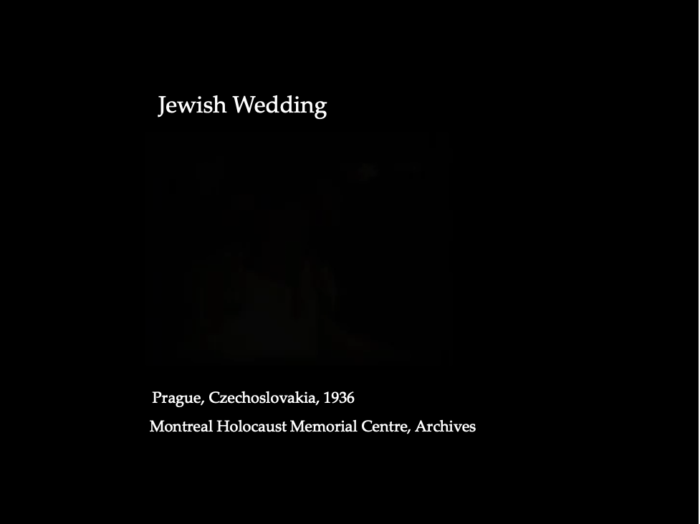
Jewish Wedding
Prague, Czechoslovakia, 1936
Anka Voticky narrates the video made from the original eight mm film. The archival footage of the Voticky family, which occurs throughout the presentation, should be used to contrast the vile image of Jews presented in the Nazi propaganda.
It should be emphasized that Jews in pre-war Europe lived normal lives and adopted the customs of the countries they lived in, speaking the language and as in the case of the majority of German Jews who felt that they were “German” first and Jewish as a second, incidental identity.
Montreal Holocaust Memorial Centre, Archives
Slide 24
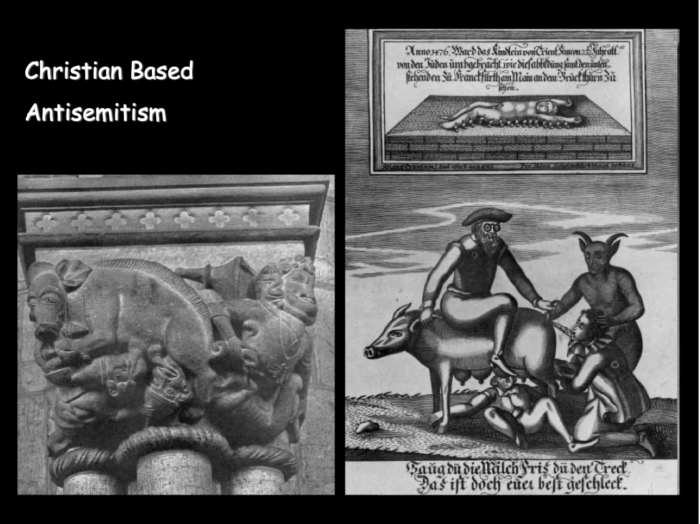
From the Middle Ages, to the modern era, the Judensau was a very common symbol of antisemitism found on churches and other public buildings. The term Judensau literally means “Jewish sow” or “sow of the Jews.” In all of these images, the sow is portrayed as the “Jewish wet-nurse,” that nurtures Jews with its milk as well as its excrement. The juxtaposition of Jews with sows or pigs was particularly offensive, because it played on the Jewish dietary laws of kashrut that forbid Jews to eat certain types of meat, including pork.
The first image represents a kneeling Jew embracing a pig. It forms part of the walls of the Marienkirche in Lemgo, Germany. The second Judensau is from the Uppsala Cathedral in Corbel, Germany. The engraving is from the mid-fourteenth century.
The last image, showing the Frankfurt Judensau, was reproduced in the seventeenth century. It was originally a wall painting on a public passage of the old bridge tower in Frankfurt, Germany. It remained on the bridge from about 1475 to 1801, when the bridge tower was demolished. The painting combined two themes: the martyrdom of Simon of Trent and the Judensau. The image of Simon of Trent as a Christian martyr was dramatized by the fact that the painting was positioned next to an image of the crucifixion. Because of its popularity, it was frequently reproduced in the form of prints or engravings. The upper image makes reference to the ritual murder myth, which alleged that Jews used the blood of Christian children to make matzah, the unleavened bread eaten at the Jewish holiday of Passover.
The German text above the image of the child reads: “In the year of 1476, the child Simon of Trent was two and a half years old, killed by the Jews, as the image below shows, also to be seen in Frankfurt on the old Bridge Tower.” The text at the bottom of the print states: “Suck the milk, eat the excrement. Isn’t that your favorite sweet?” The original painting on the Old Bridge Tower in Frankfurt shows that the circular badges of the Jews depict small but clear pictures of boars.
Shar, Isaiah. The Judensau – A Medieval Anti-Jewish Motif and its History. Warburg Institute, University of London, 1974
Slide 25

Economic antisemitism of this kind was based on the belief that Jews were involved in a worldwide conspiracy to dominate and take control of the international economy. Rothschild, a famous Jewish financier of the nineteenth century is portrayed as clasping the world with his animal-like hands. On his head, he wears a crown carrying the golden calf which, according to the Bible, the Jews worshiped in the Sinai desert after their deliverance from Egypt. Here however, the idol of the golden calf represents money, and because of his financial dealings, Rothschild is depicted as the King of the Jews. The faint writing in the background reads: “God protect Israel,” insinuating that the Jews will only prosper through their worship of money.
The title of the second image is The Invisible World Government or the Jewish Plan to Subject the World. It is taken from a Spanish edition of the Protocols of the Elders of Zion, 1930. The latter is a forged document that purports to reveal Jewish machinations to take over the world.
Between the two world wars, the Protocols made their appearance in numerous editions throughout the world, having been translated into Polish, Romanian, Hungarian, Flemish, Swedish, Latvian, and Arabic. Two trials were held before World War II in which the Protocols were declared to be a forgery, one in Port Elizabeth, South Africa in 1934, and the other in Bern, Switzerland, during 1934 and 1935.
The Protocols were initially published at the time of the Dreyfus affair (1894), by Pyotr Ivanovich Rachkovski, head of the foreign branch of the Russian secret police in Paris. The “document” served the interests of the French Right, who wanted “proof” that would implicate Alfred Dreyfus in the supposed conspiracy to transmit secrets to the Prussians. For their part, the Russians made use of the Protocols to justify their pogroms against the Jews. The first German edition appeared in 1919, published by Ludwig Müller under the pseudonym of Gottfried zur Beck. Soon after, the Nazis began to make use of the Protocols, passages from which found their way onto the pages of Der Stürmer, Julius Streicher’s antisemetic newspaper. Picture source: Antisemitism – A History Portrayed. Anne Frank Foundation, Amsterdam 1989. French Caricature, by C. Léandre, 1898
Music: Money, Liza Minnelli and Joel Grey, (Cabaret)
Slide 26
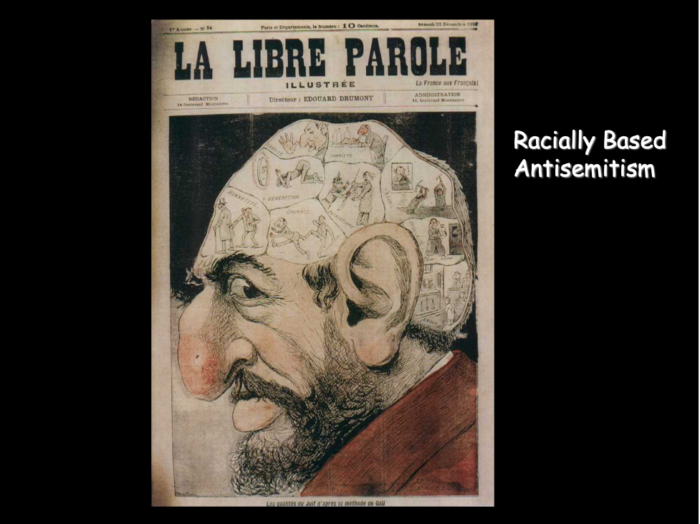
Franz Joseph Gall, born in Germany in 1758, is widely accredited as the founder of Phrenology, a pseudo-science that claimed to be able to infer personality traits from configurations of the skull. In the course of his research, for example, he compiled a large anecdotal catalogue of specific mental characteristics associated with particular bumps on the skull. Bumps were seen as signifying an express character trait, while dents were interpreted as a lack thereof. Eventually, Gall developed a “doctrine of the skull” which summarized the enormous body of data he had collected. This doctrine stated that personality and intelligence are reducible to thirty-seven powers or functions, fourteen of which were intellective (including order, locality, time, and language,) and twenty-three of which were affective (including destructiveness, combativeness, acquisitiveness, benevolence, and hate.) Gall believed that each of these powers was localized on a specific surface area of the brain and that the skull encapsulated the brain closely so that skull contours reflected deviations in the brain’s surface. (Hothersall, David. History of Psychology. Random House, NY, 1984.)
The above illustration heavily exaggerates Gall’s research conclusions. Not only does it simplify his intellective and affective functions, but also suggests that Jews as a whole could be characterized by certain personality traits, which in turn could be inferred by the structure of the “Jewish” skull. Typical “Jewish” characteristics in the illustration include dishonesty, drunkenness, cowardice, and slothfulness. The image represents a significant departure from earlier forms of antisemitism (which were based on religious and economic prejudices) in that it portrays Jews as a “race.” While religious antisemitism allowed for redemption through conversion (at least theoretically,) the concept of a Jewish “race,” where personality and even external features were seen as biologically predetermined, rendered conversion or any other such change in life style as meaningless.
Picture source: The Fallacy of Race and the Shoah, Naomi Kramer, Ronald Headland, University of Ottawa Press, Ottawa, 1998.
Émile Courtet, Les qualifiés du Juif d’après la méthode de Gall (The Jew’s Qualities after Gall’s Method,) La Libre Parole Illustré (The Free Word Illustrated), 28 December 1893.
Slide 27
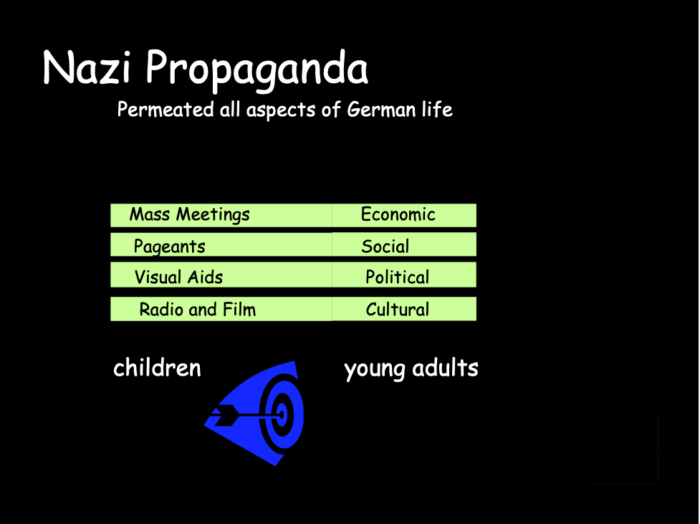
Nazi propaganda extended to all areas of German public and private life. Through different forms of communication, Germans were influenced by and indoctrinated with the goals and ideology of the Nazi party. Children and young adults were especially targeted in order to insure the future of the Party, particularly following the divisions caused by the Röhm affair. It also aimed to introduce the party’s leaders, many of whom were rarely seen or heard by the German people, in this pre-television era.
Music: Das Bächlein, Op 88 No. 1, Richard Strauss, Elisabeth Schwarzkopf
Slide 28
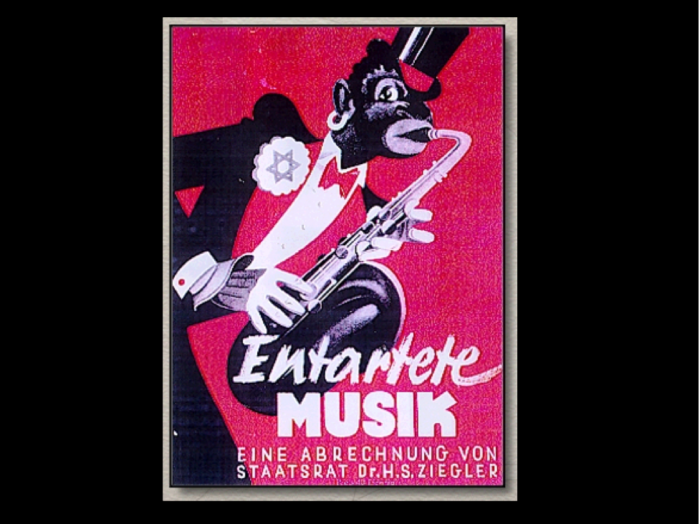
Title page to the brochure accompanying the exhibition, Decadent Music, which opened on 24 May 1938, as part of the National Music Days. The author, Hans Severus Ziegler, one of Hitler’s earliest adherents, was the general director of the German National Theatre in Weimar. The cover malevolently caricatures the Jewish composer Ernst Krenek as the lead character, a black jazz musician, in Krenek’s 1927 jazz opera, Johnny spielt auf (Johnny Strikes Up). In the opera, white girls are shown as succumbing to the magic of an Afro-American jazz fiddle.
In order to portray the decadence of this opera in particular and jazz music in general, Krenek is shown wearing a Star of David instead of a flower in his lapel. The exhibition was organized as part of the successful traveling exhibit, Decadent Art, which was also shown in Vienna, Frankfurt am Main and Chemnitz in 1937. Art by expressionist painters such as Wassily Kandinsky, Paul Klee, and Franz Marc were shown as examples of the moral and material decay of the Weimar Republic. .
Abstract and experimental works were displayed to shock the German public and were presented with the intention of showing these artists at their worst. The exhibition attracted thousands of people who were told that their tax money had been wasted by the Weimar government on these “abominations.”
Because of its black origins, and its “pulsating, sensual rhythm,” jazz was considered to be below German moral standards and aesthetically inferior to German culture. A pervasive antisemitism was intrinsic to such attitudes. While black people were supposed to revel naively in the perceived eroticism of Jazz, Jews were alleged to exploit it as part of a systematic conspiracy to corrupt the “Aryan” German culture through acts of “musical race defilement.”
Modernist atonal music, such as the compositions of the Jewish composer Schönberg, and jazz music were banned under the National Socialists.
Goethe Institut, Learning from History. (CD-ROM), Munich, 1999.
Music Wagner, Swing, Schoenberg
Slide 29
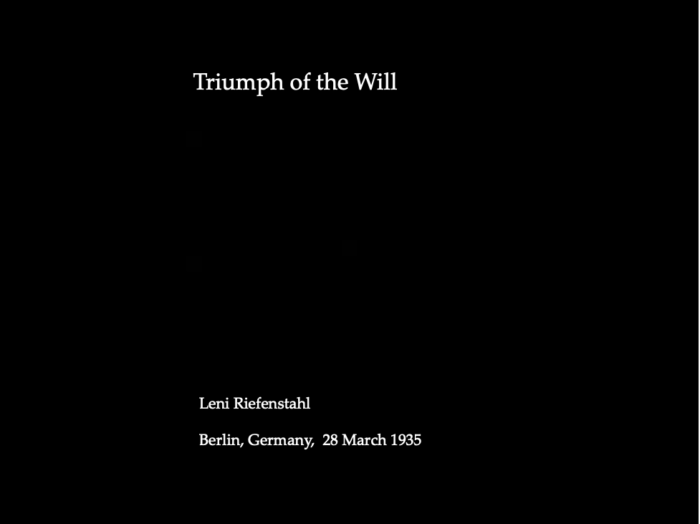
Triumph of the Will
This video clip shows an extract of the Nazi propaganda film Triumph of the Will, 1934. That year, Hitler approached the German director Leni Riefenstahl to make a documentary film about the Nazi Party Rally in Nuremberg. Riefenstahl eventually agreed, but insisted that she alone be responsible for the funding and that neither Hitler nor Goebbels (her arch enemy) be allowed to see the film before its completion.
The purpose of the film was twofold: to depict the spectacle, energy, and solidarity of the Reich, particularly following the divisions caused by the Röhm affair and to introduce the leaders, many of whom had not been seen or heard before. Another, more subtle, purpose was to impress, and at the same time intimidate, foreign audiences. The film depicted a rally which attracted about seven hundred and seventy thousand people, augmented by three hundred and fifty thousand inhabitants of Nuremberg. The finished version ran about two hours.
The rally itself, especially was planned and carefully orchestrated in order to accommodate Riefenstahl’s camera work. The images shown in this clip emphasize a sense of camaraderie among young people. The preparations for the Party rally are associated with joyful games and other youth activities, all of which were meant to instill a sense of solidarity and identification with the Nazi cause.
Source: Hull, David S. Film in the Third Reich. University of California Press, NY, 1969.
Slide 30
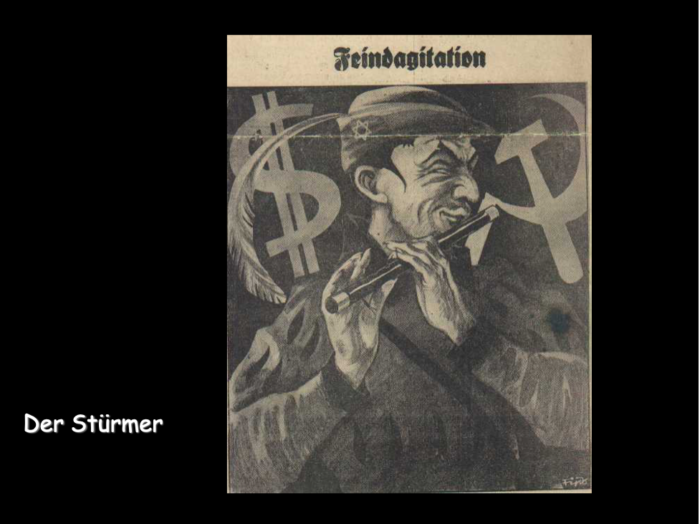
Although the Nazis regarded so-called “uncivilized races” (people from other parts of the world such as Asia or Africa, for example), as “racially inferior,” they were not seen as an immediate threat to German society and the purity of the “Aryan race.”
This image, published in Julius Streicher’s antisemitic newspaper Der Stürmer (Nuremberg, 17 February 1944, no. 7) makes reference to the German folk tale of the Pied Piper of Hameln. In the story, the town of Hameln hires the piper to rid them of the rats that plague the town. His music lures the rats away, and into a nearby river, where they drown. The town, however, refuses to pay the piper the amount originally agreed on. To take revenge, he decides to use his pipe to lure all of Hameln’s children out of the town, never to be seen again.
Like the Piper of Hameln, Der Stürmer suggests that the Jew has been admitted into the German community as a guest, but eventually steals and makes off with its treasures. He was therefore regarded as an especially cunning and insidious threat that was able to operate from within German society itself.
The background of the illustration features the dollar sign and the communist hammer and sickle, suggesting that the Jew works against Germany as an opportunistic agent of both capitalism and Bolshevism.
When Hitler took power in 1933, Der Stürmer was already one of the most popular Nazi publications, selling about twenty-five thousand copies weekly. By means of unrestrained propaganda and demagoguery, it sought to promote the idea that the Jews were the chief enemy of the Germans, and of all mankind. The slogan Die Juden sind unser Unglück (The Jews are our misfortune) was featured on the front page of every issue. The style of the paper was crude, aggressive and easily comprehensible; the articles were composed of simple, clear sentences, blunt, and repetitive.
The most striking element was the antisemitic cartoons, which became the newspaper’s mainstay after 1925. By 1938 circulation had reached about half a million copies weekly.
After the war, the publisher and owner of Der Stürmer, Julius Streicher, tried to hide under a different identity. On 23 May 1945 he was arrested and tried by the International Military Tribunal at Nuremberg. The tribunal sentenced Streicher to death, and he was executed by hanging on 16 October 1946.
Montreal Holocaust Memorial Centre, Archives
Music: Branford Marsalis ( )
Slide 31
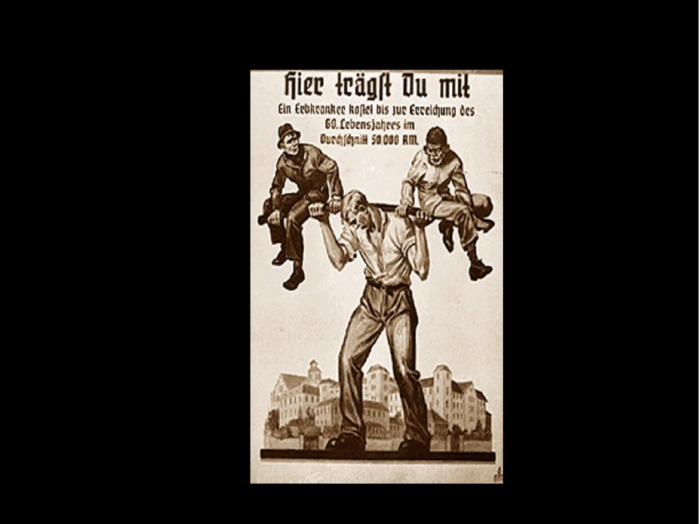
Poster of an exhibition on “racial hygiene,” taken from the illustrated monthly, Volk und Rasse, October 1936. The caption reads, “You share the burden. A person with a genetic illness will cost an average of fifty thousand Reichsmarks by the age of sixty.”
Under the Third Reich, the Nazis founded the so-called euthanasia program, which utilized murder to improve the quality of the German “race.” The aim of the operation was to rid the German people of “life unworthy of life,” and in doing so, to free hospital-beds, doctors, and nursing staff for more “reasonable” purposes.
Questionnaires were sent to private and public sanatoria and nursing-home personnel. Patients were classified in three groups: those suffering from schizophrenia, epilepsy, and various other forms of mental illness, as well as neurological conditions such as Huntington’s Disease; all patients who had been institutionalized for five years or more; foreigners and the criminally insane. The questionnaires were returned to the central T4 office, where a medical file under each person’s name was opened. Three different experts evaluated the file and made a decision as to whether the patient was fit to live.
Gassings took place in six “euthanasia” facilities in Germany and Austria. Patients were brought from hospitals to the facilities on buses provided by the T4 program. Families were to be informed of the transfer only after it had taken place. Only physicians were permitted to turn on the carbon monoxide gas flow. This was after an examination lasting about a minute, the purpose of which was to confirm the patient’s identity and calm the victims by deceiving them about what was to come. Their backs were marked with a coloured crayon or stamped for later identification. The corpses were cremated after brains for “research” and gold teeth were removed. Many of the killing techniques were later employed in the killing of Jews and other groups in the death camps of Eastern Europe.
Although the program officially ended in 1941 (due in large part to popular protests, especially from the German clergy) the killings continued throughout the war. Although seventy thousand Germans were murdered under the official T4 euthanasia program, it is estimated that by 1945, the number of victims had reached approximately two hundred thousand.
Picture source: Goethe Institut, Learning from History. (CD ROM), Munich, 1999.
Slide 32
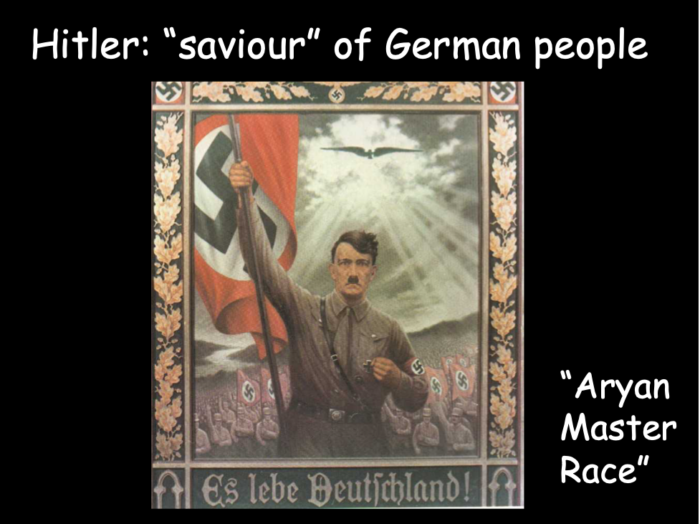
From the point of view of the Nazis, the formidable Jewish threat to “Aryan racial purity” combined with other drains on the system, required the emergence of a strong leader who would protect the “German blood,” and liberate the German nation from the grasp of international influence and control.
The sound sample gives an example of one of Hitler’s many speeches to the German people.
Slide 33
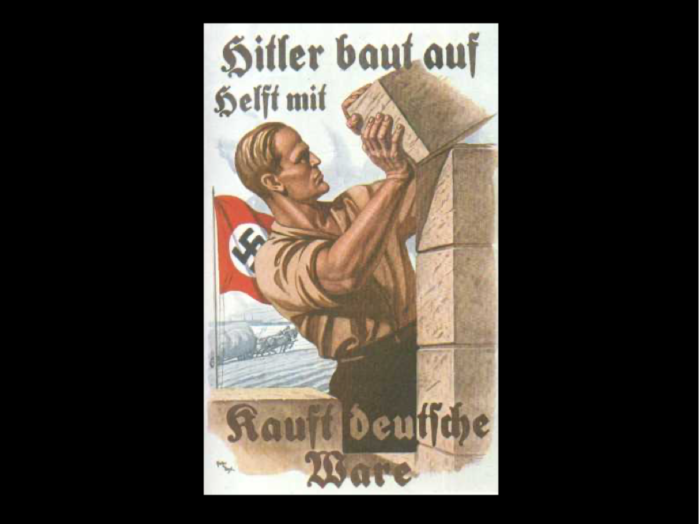
In addition to the issue of race and political strength, Hitler also promised to repair the depression-ridden German economy. The poster text reads: “Hitler is rebuilding. Help him. Buy German Goods.”
The Song of the Partisans accompanies slides 32-37.
The Nazi propaganda exhorted the German nation to rebuild. As the Nazis promised a prosperous economy to their citizens from 1933 onward, they portrayed Jews as vermin, leeches, and parasites who could only undermine the restoration of German power and prosperity.
From 1939 on, Jews were rounded up and transported to ghettos and concentration camps. The Nazi goal was to rid Europe of its Jews. Within this context, where Jews faced dehumanization and annhilation, any act which opposed this diabolical process was regarded as resistance. Resistance took many forms, active, passive, spiritual, rescue, and even the will to survive in the most desperate circumstances.
Organized armed resistance was difficult for many reasons-the lack of weapons, a population dispersed over hundreds of ghettos and camps, none of which had contact with one another and the near impossible task of training fighters under the eye of the Nazis.
Picture Source: Rodes, Anthony. Propaganda-The Art of Persuasion: World War II. Chelsea House Publishers, Hong Kong, 1983.
Hirsch Glick, a poet and artisan who was born in Vilna, Lithuania composed the Song of the Partisans. He composed poems that were meant to be sung and continued writing even as a prisoner in the camps. He composed this anthem based on a tune by two Soviet Jewish composers, the brothers Diametric and Daniel Okras. It was sung in many locations under Nazi rule.
Song of the Partisans
Zog nit keyn mol az du geyst dem letsten veg,
Khotsh himlen blayene farsthtelen bloye teg.
[Never say you are walking your final road,
Though leaden skies conceal the days of blue.]
Kumen vet nokh undzer oysgebenkte sha’ah,
S’vet a poyk ton undzer trot mir zaynen do!
[The hour that we have longed for will appear,
Our steps will beat out like drums: We are here!]
Fun grinem palmenland biz vaysen land fun shney,
Mir kumen on mit undzer payn, mit undzer vey.
[From the green lands of palm trees to lands white with snow,
We are coming with our all pain and all our woe.]
Un vu gefalen s’iz a shpritz fun undzer blut,
Shprotzen vet dort undzer gevurah, undzer mut.
[Wherever a spurt of our blood has fallen to the ground,
There our might and our courage will sprout again.]
S’vet di morgenzum bagilden undz dem haynt,
Un der nekhten vet farshvinden miten faynd.
[The morning sun will shine on us one day,
Our enemy will vanish and fade away.]
Nor oyb farzamen vet di zun in dem kayor,
Vi a parol zol geyn dos lid fun dor tsu dor.
[But if the sun and dawn come too late for us,
From generation to generation let them be singing this song.]
Dos lid geshriben iz mit blut un nit mit blay,
S’iz nit keyn lidel fun a foygel oyf der fray,
[This song is written in blood not in pencil-lead.
It is not sung by the free-flying birds overhead,]
Dos hot a folk tsvishen falendike vent,
Dos lid gezungen mit naganes in di hent!
[But a people stood among collapsing walls,
And sang this song with pistols in their hands!]
Hirsch Glick
Slide 34

The VW (Volkswagen means the “people’s car” in German) became the symbol of German economic revival and the promise of prosperity.
Picture source: Rodes, Anthony. Propaganda-The Art of Persuasion: World War II. Chelsea House Publishers, Hong Kong, 1983.
Slide 35
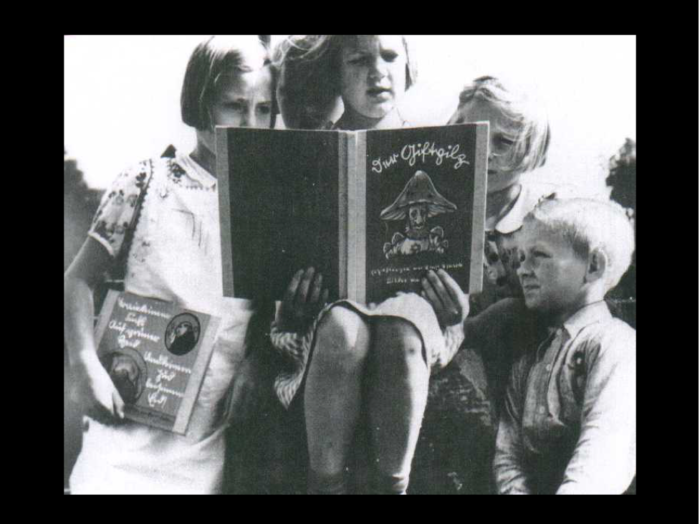
This photograph shows a group of German children perusing a typical antisemitic children’s book. The title of the book is Der Giftpilz (The Poisonous Mushroom), Nuremberg, Germany, 1935. In its illustrations, Jews are likened to toxic mushrooms that multiply and spread rapidly, poisoning everything with which they come in contact.
Picture source: German National Archives (Bundesarchiv).
Slide 36

Salem Cigarettes, located in Dresden, Germany, distributed these cards which were collected by German youth. They are further examples of the Nazis’ use of propaganda. Characteristic of Nazi propaganda, they appealed to the emotions in order to convey a message to the masses. The youth in Germany were instilled with elements of Nazi ideology and, in this way, traditional childhood activities were redirected to Nazi organizational behaviour such as that of the Bund Deutcher Madäl.
Montreal Holocaust Memorial Centre, Archives
Slide 37

This book is another example of antisemitic children’s propaganda. On the left, a physically healthy, blond, and blue eyed Aryan worker, with shovel in hand, the symbol of honest and hard work; on the right, a fat a misshapen Jew, smoking a cigar and carrying a briefcase, symbolizing his role as the greedy money-lender. These images taught German children to racially label and distinguish between Aryans and Jews. The entire book is written in verse.
Trust no Fox in the Green Meadow, and no Jew in his Oath, Verlag der Stürmer, Nuremberg, 1936.
Montreal Holocaust Memorial Centre, Archives
Slide 38
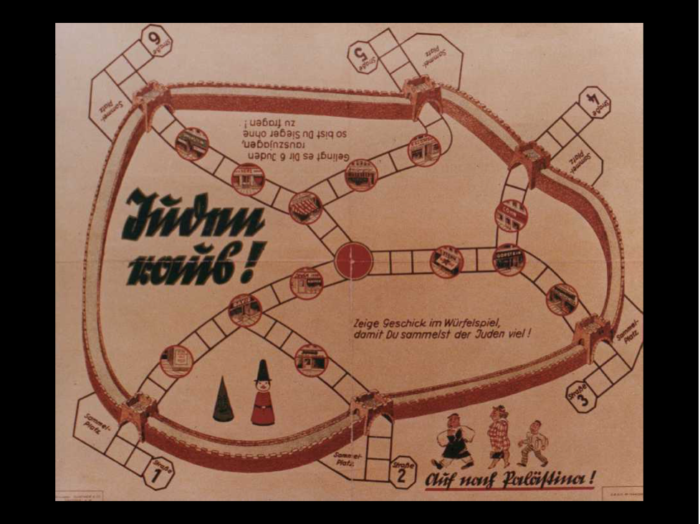
This board game shows how children were targeted and subliminally influenced by Nazi propaganda. The name of the game is Juden Raus (Jews Out.) The first player to “move” six Jews out of the medieval walls of the German city is the winner. The text at the bottom right reads: “Let’s go to Palestine,” depicting three travelling Jews. A German rhyme in the centre of the game states: “Show your ability in the game of dice, so that you can collect many Jews.” Squares outside the city walls are labelled Sammelplatz (collection point)—the same term that would later be given to the actual collection points from which Jews were taken to the ghettos and deported to camps.
Source: Hull, David S. Film in the Third Reich. University of California Press, NY, 1973.
Music: Iko, Iko, The Dixie Cups (The Big Easy)
Slide 39

Film was another method of disseminating Nazi propaganda. The propaganda Minister Goebbels was quick to realize that this new art form could reach a far wider audience than books or theatre. Thanks to governmental support cinema attendance quadrupled in the period from 1933 to 1942. Because the Nazis considered the cinema such a powerful medium, its personnel were immediately required to take the oath of loyalty to the Führer. Censorship was extensive, and film topics had to approved before production could begin.
Among many other propaganda films, the Nazis commissioned a number of antisemitic movies. The Eternal Jew, directed by Dr. Fritz Hippler in 1940, lasts about 45 minutes. In 1940 Goebbels called for the production of an antisemitic “documentary.” During the war in Poland, Hippler had supervised some documentary footage on life in the ghetto, intended for archival purposes. When Hippler was mandated for the project he went back to shoot additional footage in Warsaw and Lodz. Shots of emaciated ghetto inhabitants appear in Der Ewige Jude (The Eternal Jew), advertised in the poster below. The film was meant to portray Jews as “subhuman” in nature.
The film also compares Jews to rats, and declares that, just like vermin, Jews are the carriers of human disease and pestilence. It describes how Jews have “evolved” from the ghettos in order to “infiltrate” German society and disguise their real origins. Later scenes feature Passover celebrations and Talmud classes, illustrating the supposedly “disgusting” nature of Jewish cultural life. In the final scenes, a brutally repulsive treatment is given to Jewish ritual slaughtering techniques, representing them as inhumane and despicable. The film ends with contrasted scenes of “German men and German order,” as the official synopsis puts it, “which fill the spectator with a feeling of deep-seated gratification for belonging to a people whose leader has absolutely solved the Jewish problem.”
Source: Hull, David S. Film in the Third Reich. University of California Press, NY, 1973
Slide 40
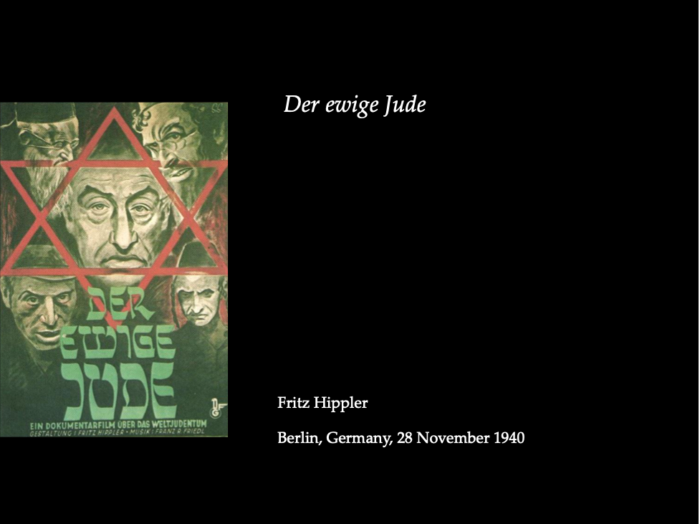
The Eternal Jew
Six-minute video clip.
Slide 41

Summer Holidays
The Voticky family’s last vacation in Yugoslavia, 1937. Note the swastika on the German ship. A successful propagandist gives the illusion of being omnipresent.
Montreal Holocaust Memorial Centre, Archives
Slide 42
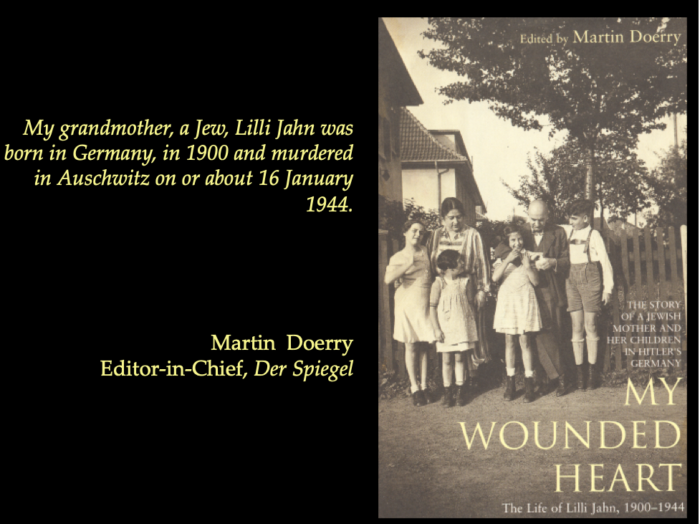
The next six slides portray the experience of a Jew, Lilli Jahn, who did not survive the Holocaust.
Lilli Jahn an assimilated Jew married to a Gentile (Ernst Jahn later divorced her), was a respected doctor and the mother of five children. She was imprisoned in a labour camp at Breitenau in 1943. Most movingly, she wrote to her children and they to her during her imprisonment. Lilli Jahn died in Auschwitz on or about 17 June 1944. After the war, Lilli’s son Gerhard, became Minister of Justice in Willy Brandt’s cabinet, secretly kept the letters. Gerhard Jahn bequeathed the letters to his sisters in 1998. Lilli Jahn’s grandson, Martin Doerry, edited the letters.
Doerry, Martin. My Wounded Heart The Life of Lilli Jahn 1900-1944, Translator, Brownjohn, John. Bloomsbury, New York, 2004.
Slide 43
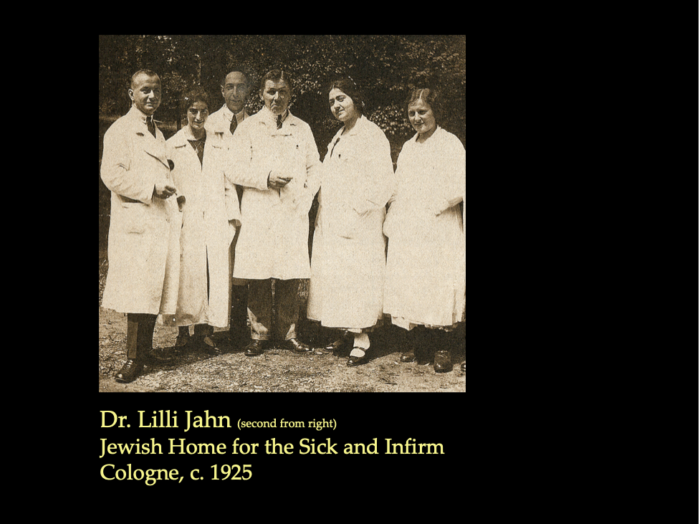
Doerry, Martin. My Wounded Heart The Life of Lilli Jahn 1900-1944, Translator, Brownjohn, John. Bloomsbury, New York, 2004.
Slide 44
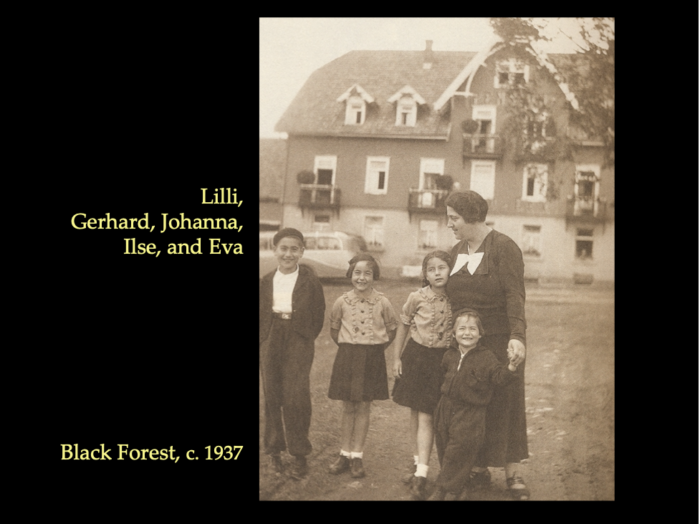
Doerry, Martin. My Wounded Heart The Life of Lilli Jahn 1900-1944, Translator, Brownjohn, John. Bloomsbury, New York, 2004.
Slide 45
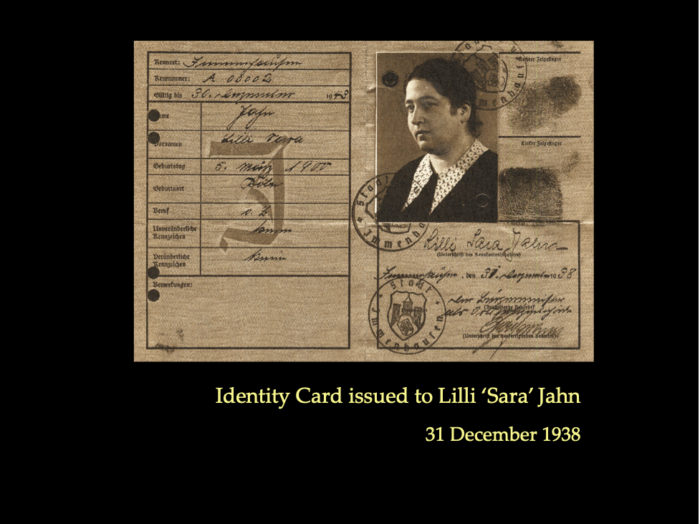
Doerry, Martin. My Wounded Heart The Life of Lilli Jahn 1900-1944, Translator, Brownjohn, John. Bloomsbury, New York, 2004.
Slide 46
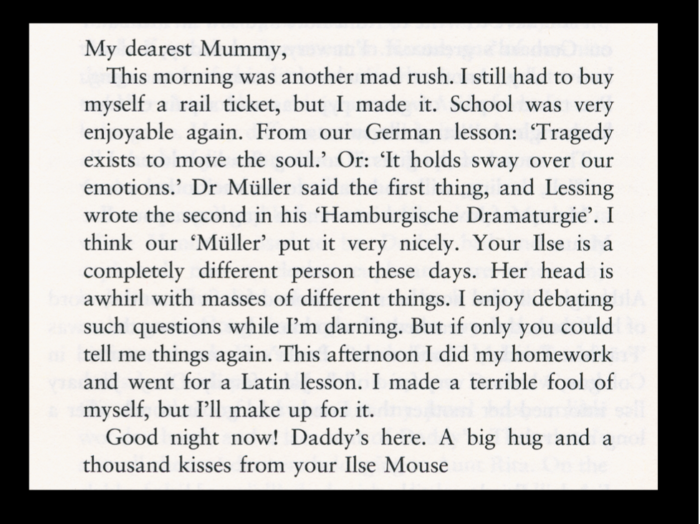
Doerry, Martin. My Wounded Heart The Life of Lilli Jahn 1900-1944, Translator, Brownjohn, John. Bloomsbury, New York, 2004.
Slide 47
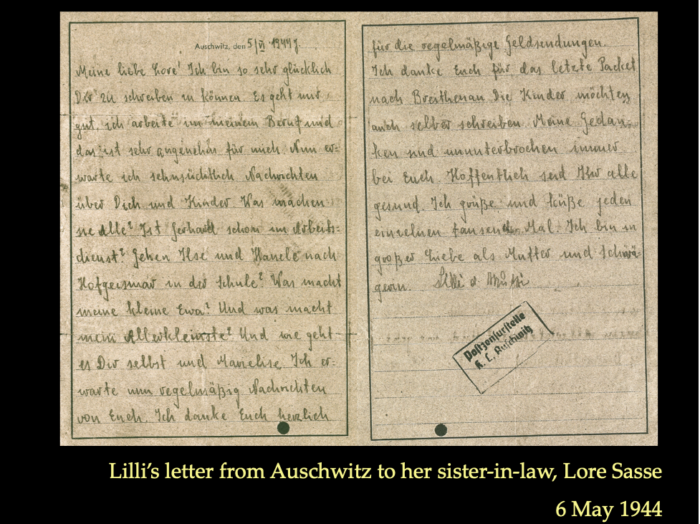
This is a letter sent by Lilli on 5 June 1944 to her sister-in -law, Lore Sasse. “The letter itself was written in pencil and probably dictated. Only the somewhat shaky “lilly o. Mutti” (Lilli or Mummy) seems to be in Lilly’s handwriting. Some fellow prisoner with an imperfect command of German, on the other hand, probably wrote the text, because the original contains a number of spelling mistakes. Lilli was evidently too debilitated to write herself. The choice of words sounds curiously stilted, though all such letters had to confine themselves as far as possible to non-committal stock phrases.” *
My, dear Lore,
I’m so happy to be able to write to you. I’m well, I’m working at my profession, and that’s very pleasant for me. Now I’m eagerly awaiting news of you and the children. What are they all doing? Has Gerhard already joined the Labour Service? Are Ilse and Hannele going to school in Hofgeismar? What is my little Eva up to? And what is my littlest one doing? And how are you yourself and Marilis? I now await news of you at regular intervals. Cordial thanks for the regular remittances. Thank you for your last parcel to Breitenau. The children may also write themselves. My thoughts are with you constantly I hope you’re all well. I greet and kiss each one of you a thousand times. With much love as mother and sister-in-law.
Lilli or Mummy
Doerry, Martin. My Wounded Heart The Life of Lilli Jahn 1900-1944, Translator, Brownjohn, John. Bloomsbury, New York, 2004. *(page 251)
Slide 48
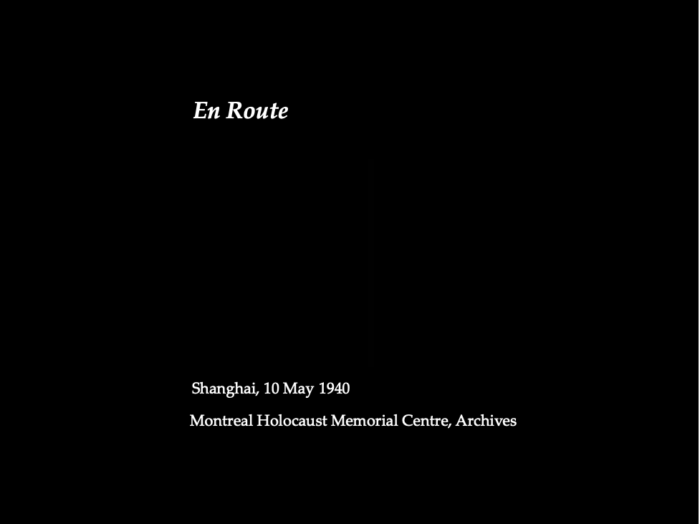
Shanghai
The Voticky family survived the Holocaust in Shanghai. It was the only place in the world where one could land without a visa or official paper of any kind. Some seventeen thousand Jews found a safe haven in Shanghai.
The refugees found two Jewish communities in Shanghai. The smaller community consisted of Sephardim from Baghdad. The larger community of Russian Jews had emigrated after the Bolshevik Revolution of 1917 and after the Japanese occupation of Manchuria in 1931 and 1932. The Russian Jews never attained the economic and social success of the Sephardim and remained for the most part, small traders and shopkeepers.
Two local Sephardic relief committees and the American Jewish Joint Distribution Committee (Joint) set up five large refugees camps for the European Jews. They managed to recreate some aspects of their European lifestyle, establishing a synagogue, a German language press, two elementary schools, theatrical and musical productions, and even a dancing school.
With the advent of the war in the Pacific, events took a turn for the worse for the Jews of Shanghai. The transmission of funds from the Joint was forbidden. On 18 February 1943 under Nazi pressure, the Japanese established a ghetto, euphemistically referred to as the “restricted area.”
In December 1943, the American government permitted the transfer of funds once again to enemy occupied areas in Europe and China.
Most of the refugees were unable to return “home” at the end of the war. About half found their way to the Western Hemisphere, while the rest made their way to the newly established state of Israel. By the time the Maoist Communist regime took over in 1949, most Jews had left. The few thousand remaining left in by the mid-1950’s, marking the end Jewish life in China.
Montreal Holocaust Memorial Centre, Archives
Slide 49
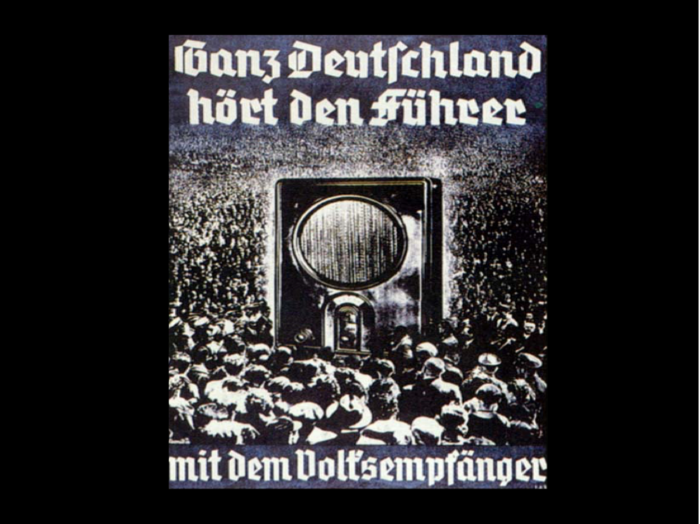
“What the press was to the 19th century, radio will be to the 20th,” Goebbels declared as he opened the tenth Deutsche Funkausstellung (German radio show) in Berlin on 18 August 1933. For Goebbels, radio was the “chief and major mediator between the Movement and the Nation, between Idea and Man […] We need broadcasting that is in step with the nation, radio that works for the people.”
(Bermeier, H; Lotz, R. Hitler’s Airwaves. Yale University Press. New Haven, 1997)
Indeed, the National Socialists proceeded to create Germany’s most formidable propaganda machine. In order to ensure that every household could receive German radio, Goebbels launched the production of the Volksempfänger (people’s set.) Using this radio set, listeners were able to receive the nearest Reichssender (regional station) on medium wave, and the Deutschlandsender (national station) on long wave. For obvious reasons, short-wave reception was not provided.
On 25 May 1933, production began on the first 100,000 sets. The Volksempfänger was significantly cheaper than other, privately produced radio sets, and its launch was a tremendous success. While a total of 4.3 million receivers had been registered by 1 January 1933, this number climbed to 8.2 million by the following year, and to 9.1 million by 1938. In 1941, there were just fewer than 15 million radio receivers in Germany, reaching a population of about 50 million listeners. Although the National German radio fell under the auspices of Josef Goebbels as Propaganda Minister, it was frequently used by Hitler himself as a means of communication with the German people.
The effects of Hitler’s radio broadcasts, which enabled the average German to hear the Führer in his own living room, cannot to be underestimated. In the course of party rallies and meetings especially, Hitler’s broadcasts would be transmitted across Germany.
The slide depicts a propaganda poster encouraging Germans to listen to the Volksempfänger. The text reads: “All of Germany hears the Führer with the Volksempfänger.”
As the audio clip shows, even the BBC relied on the German radio for information about Hitler’s death.
Picture Source: Rodes, Anthony. Propaganda- The Art of Persuaison: World Wat II. ChelseaHouse Publishers, Hong Kong, 1983
Slide 50

This section looks at contemporary “hate” sites and provides students with the analytical skills to evaluate websites.
Music: Stand up for Your Rights, Bob Marley and the Wailers
Slide 51

We now turn to the Internet and the unregulated flow of information that it represents.
The Internet began in 1969 with four computers in the American Department of Defense, (ARPANET.) When the system was designed, its goal was to ensure that the information sent via the Internet was secure, especially in the light of Cold War considerations.
There is no single authority or president of the Internet. The Internet Society (ISOC) is a voluntary exchange through Internet technology. It has a council of elders, which is responsible for the technical management and direction of the Internet. This is the Internet Architecture Board (IAB.) The group sets technical standards and allocates resources such as addresses – each computer has a unique 32-bit address.
The Internet is a network of computers. When computers are “networked,” all the computers in the system are connected. It functions like a highway system as individual paths connect to form a greater and extensive road network. Just as one can take different roads to get to the same destination, information travelling on the Internet can take many routes to arrive at one point or address. The “roads” connecting the computers are cables and wires. The same wires that provide telephone service also provide access to the Internet. Smaller networks are hooked up to larger networks much as provincial governments communicate with federal governments, which in turn have relations internationally. Because most information is longer than fifteen hundred characters, the system transmission control protocol (TCP) was developed to send large amounts of information. TCP breaks information into pieces, numbers each piece and places it into an IP envelope which can be sent on the Internet.
On the receiving end, a TCP software package collects the envelopes, extracts the data, and puts it in proper order. If data is missing, it asks the sender to retransmit them. Another standard protocol user datagram protocol (UDP) is used for sending shorter messages and is much simpler than the TCP. Using file transfer protocol (FTP) one is able to move things over the Internet.
The Internet has also become a form of “Multi-net” as modern web sites present information through all kinds of media, such as radio, film, music, and visual text.
Music: Is Anybody Out There? Pink Floyd
Slide 52
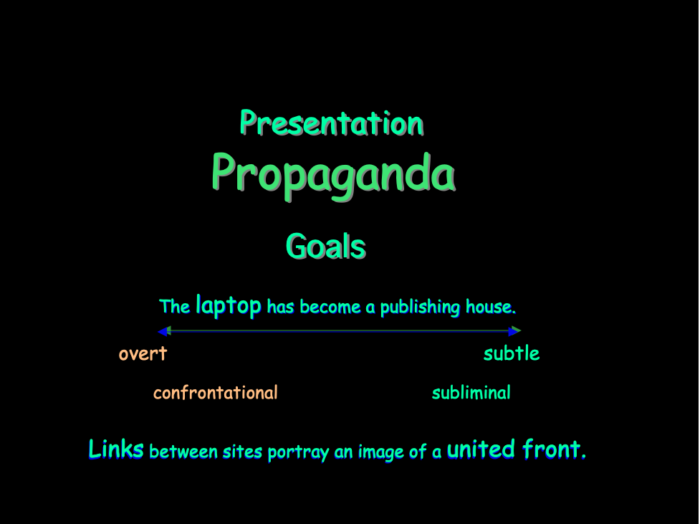
On the Internet, the presentation and the goal of propaganda (which is to incite action) have become one and the same. The viewer can immediately respond to what he sees on the net by writing e-mails, boycotting certain products or companies, or even building a web-site of his own. In other words, the time it takes to react to an incitement of action has been significantly shortened as the entire process has speeded up over the internet.
Anyone with a laptop computer has the possibility to publish information on the internet. The propaganda presented there can range from overt to confrontational, from subtle to subliminal. The inter-linkage between sites portray the image of a united front, giving extra credence to the “cause.”
Slide 53
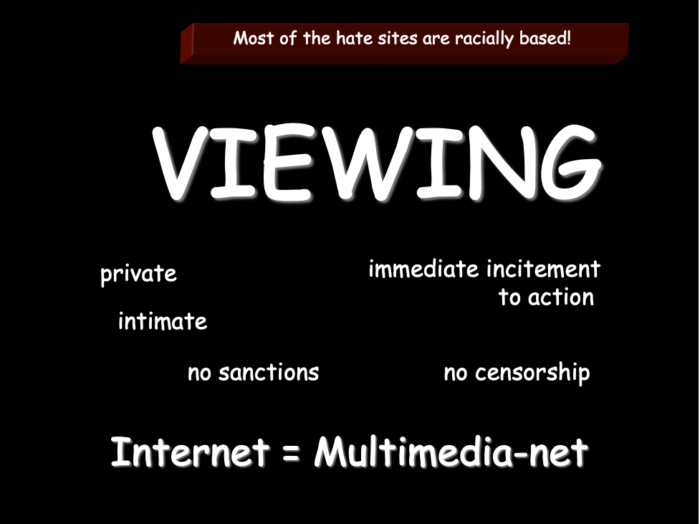
Viewing information on the Internet is very different from the way that propaganda was traditionally presented (by public displays for example.) It is private and intimate, without sanctions or censorship.
The Internet has also become a form of “multi-net” as modern web-sites present information through all kinds of media, such as radio, film, music, and visual text.
Slide 54
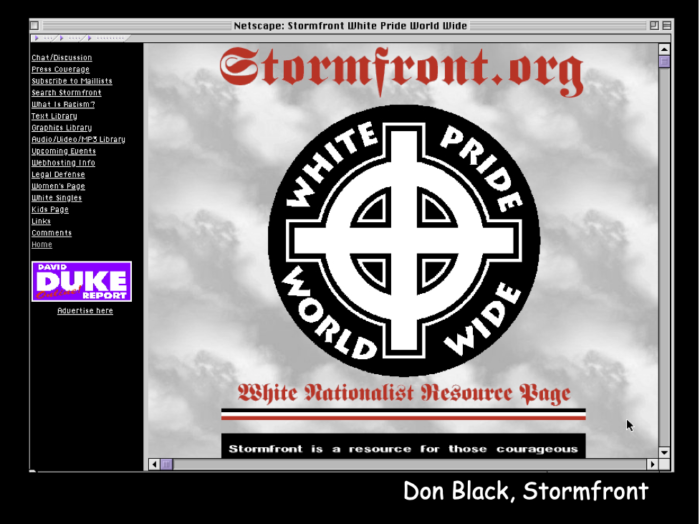
Stormfromt
http://www.stormfront.org
Stormfront is one of the first and most prominent white supremacist sites on the Internet. Most other hate sites link up to www.stormfront.com. There is a clear emphasis on Nazi-related imagery, such as the gothic script, and the Celtic cross in the centre. Other parts of the site, such as a Woman’s page and Kid’s page, are meant to show that this web-site offers something for everyone.
Slide 55

This page is accessed through the Women’s page, enforcing the stereotype that women are typically interested in matters relating to cooking and homemaking. The imagery and text is a vile insult to those who observe the Jewish dietary laws of Kashrut (the text on the pig reads “Kosher” in Hebrew).
In an obvious distortion of the facts, the Kosher sign is presented as a “secret Kosher Tax Stamp,” and the Jewish community as the direct profiteers of Kosher product sales. This is a good example of how propaganda can be countered by a clear factual presentation: the Kosher symbol is never secret, but can always be identified on a product. Money spent on Kosher products is never collected in the form of a tax, and in no way benefits the Jewish community. The costs incurred by producing normal products in a way that is compatible with Jewish dietary laws is not passed on to the consumer – the food producer General Mills wrote an e-mail to the Stormfront site, in which it stated that the cost per item is no more than 1/20,000 of a cent.
Music: Is Anybody Out There? Pink Floyd
Slide 56

White Aryan Resistance
http://www.resist.com
This is another example of a very overt racist Internet site. It is very common for such sites to allude to the “struggle” or “war” that is going on in society between members of different “races.” Again, aggressive imagery and the idea of an ongoing battle is meant to incite a sense of urgency in the viewer.
Slide 57
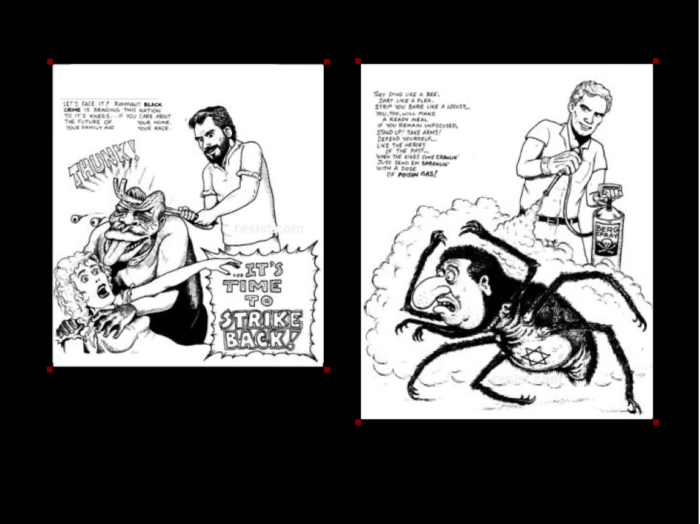
The Insurgent
http://www.resist.com
Drawing directly from Nazi and Holocaust related imagery, these contemporary cartoons purposely make use of the most vile and insulting images. Both the Jew and the African American are seen as serious threats to the “white order,” that is supposedly under attack.
The above images are very similar to the kind of racist caricatures that were widely used in Nazi propaganda. While the content is much the same, however, the manner of presentation is rather different. In this sense, the Internet has replaced the newspaper or public poster in its presentation of propaganda.
Slide 58
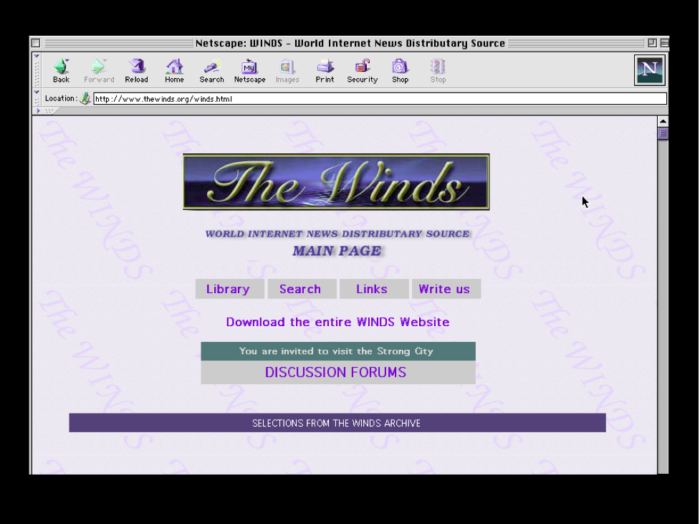
Winds
http://thewinds.arcsnet.net/
In contrast to the two previous web-sites, this site is more subtle and presents itself as a discussion forum. At first glance, the uninformed viewer suspects nothing, and indeed, there is no overt racist imagery at all.
Slide 59
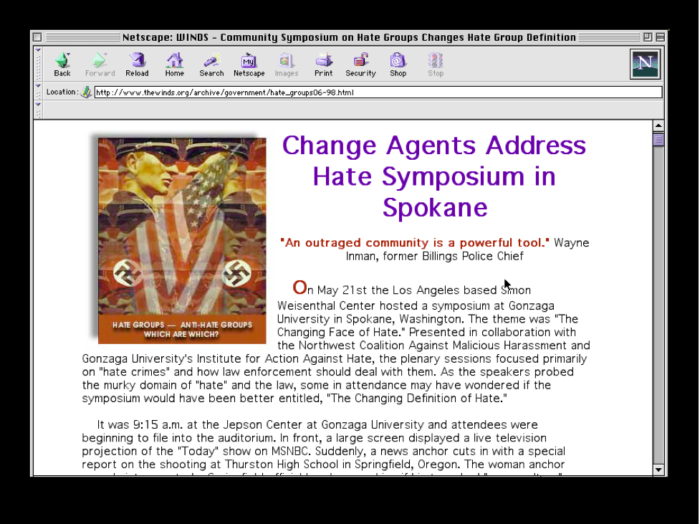
Winds
http://thewinds.-arcsnet.net
Upon closer examination, however, we see that articles are often biased and tend to muddle terms. In the image above,the Nazi swastika superimposed on the American flag. The text reads: “Hate groups – Anti-Hate groups. Which are which?”. It implies that groups who oppose racism and white supremacists are extremists themselves, and no different from those they are trying to fight.
Slide 60
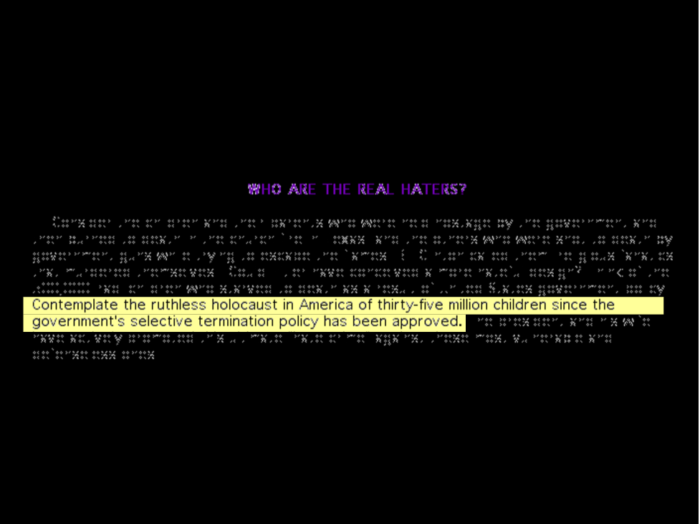
Winds
http://thewinds.-arcsnet.net
Conspiracy theories are also a common feature in this site. The title “Who are the real haters?” suggests that American government policy is a deliberate attempt to exclude and suppress certain groups, such as white supremacists. Conspiracy theories of this kind often imply that governments have “sold out” to minority groups, and the Jewish lobby.
The highlighted section equates the government abortion policy to Nazi genocide, by labelling it as a “Holocaust.” Such deliberate misuses of the word “Holocaust” will lead to a banalization of the word.
Slide 61

American Dissident Voices
http://www.natall.com/
American Dissident Voices is a weekly propaganda radio broadcast on the Internet by the white supremacist organization “National Alliance.” By using the Internet, it avoids every kind of censorship that might apply to conventional radio broadcasts. The broadcast implies that self-esteem and confidence must primarily be sought in “racial” characteristics. For white people, “racial” identity is therefore seen as the most fundamental form of self-identification.
Slide 62

Visualizing Memory….a last detail
The video clip from Visualizing Memory. . .last detail contrasts the response of the German and Danish nations to the Nazi persecution of Jews.
During the Holocaust, Denmark was one of the only countries that undertook a co-coordinated and organized effort to save its Jewish citizens from Nazi persecution. Under German occupation, the Danish people were warned of the imminent arrest and deportation of the Danish Jews. In the course of a spontaneous rescue operation, almost the entire Danish Jewish population, numbering about seventy-two hundred, was saved by being ferried to neutral Sweden in small fishing boats in October 1943.
In addition, the issue of memorialization of former Nazi concentration camps is raised and the question of whether or not to preserve former concentration camps and death centres is addressed.
Kleinmann Family Foundation
Slide 63
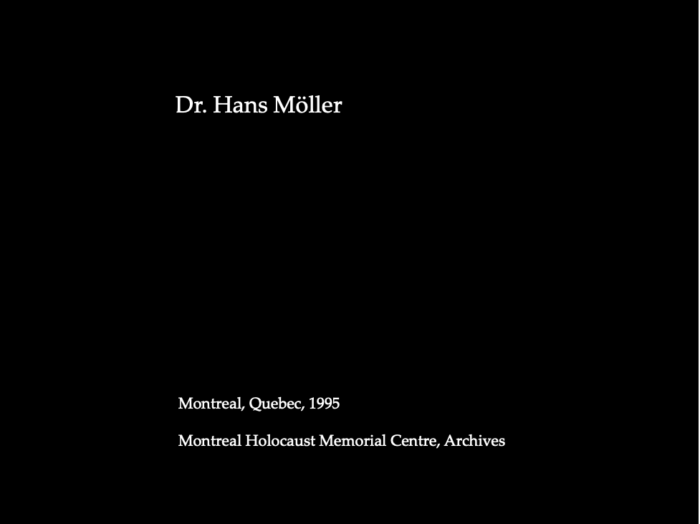
Dr. Hans Möller
Dr. Hans Möller was very much involved in the Danish resistance as well as the rescue operation. In the video clip, he quotes a text that was read in almost every Danish church during the German occupation. It reinforces the belief that even in situations as seemingly hopeless and dangerous as those that prevailed under Nazi oppression, it was possible for one individual to make a difference.
Montreal Holocaust Memorial Centre, Archives
Slide 64
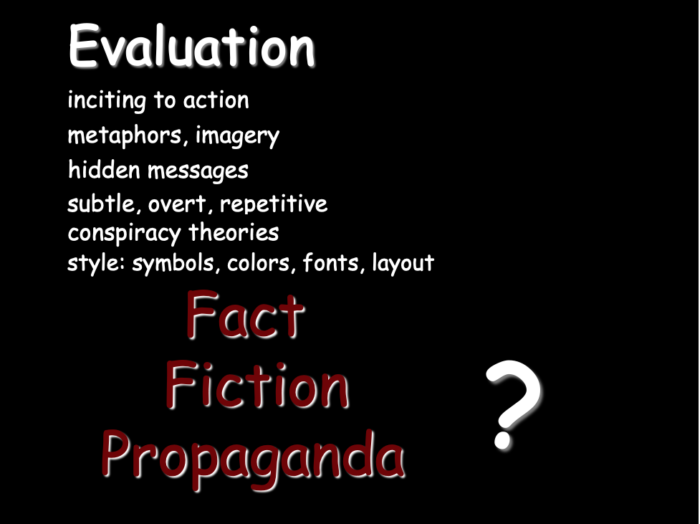
At the end of the presentation, it is important to review some of the points made throughout.
While on the Internet, viewers should always be aware of the messages presented. Elements of style and imagery, as well as other aspects, such as the incitement to action, conspiracy theories, and the emphasis on “us and them,” are typical of propaganda sites.
Slide 65
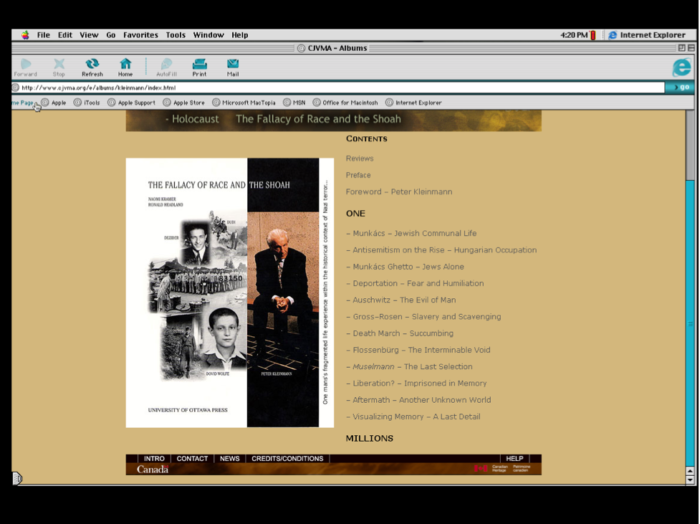
The Fallacy of Race and the Shoah
This is a website about Part One of The Fallacy of Race and the Shoah by Naomi Kramer and Ronald Headland. The text uses the example of one individual to approach universal issues that inevitably arise in discussing the Holocaust-evil, courage, human dignity, moral responsibility, and the existential qualities of humankind. The book consists of two main sections-the first involves interpretation and reflections on the meaning of one individual’s experiences during the Shoah.
The second section sets forth the historical context in which these experiences occurred. It contains a comprehensive historical summary of the Shoah and constitutes a succinct synopsis of existing secondary literature and primary sources. A bibliography and extensive glossary of terms relating to both Jewish life and the Shoah is included.
Slide 66

Kissing Cousins
Anka Voticky, describes how her son Milan, who was sixty-years old when she provided the narration for the home movie made in 1935, still misses his cousin Harry Knöpfelmacher who was murdered in Auschwitz on 14 July 1944.
Montreal Holocaust Memorial Centre, Archives
Slide 67

One Person Can Make a Difference
During the Holocaust many “righteous gentiles” acted courageously and at great risk to their own lives and those of their families by hiding Jews, feeding them, and rescuing Jewish children. The following three individuals are among the 20,757 “righteous” that have been recognized by Yad Vashem.
Music: 99 Luftballons, Nena
Chiune Sugihara, Japanese consul general in Kovno, Lithuania, who in July-August 1940 issued more than 2,000 transit visas for Jewish refugees. Due to his refusal to obey the Ministry of Foreign Affairs instructions not to grant transit visas. In September 1940 Sugihara was sent to Prague in Bohemia and then to Bucharest, Romania, Germany’s ally, where he remained until after the end of the war. During the victorious Soviet army’s march though the Balkans in 1944, the Soviets arrested Sugihara together with other diplomats from enemy nations. Soviet authorities held him and his family, under benign conditions, for the next three years.
Upon his return from Europe in 1947 Sugihara was asked to submit his resignation for his insubordination seven years earlier. On 24 January 1985 in Sankei Shinbun Yukan Tokuho he made the following comments to to Ryusuke Kajiyama, “I really had a hard time , and was unable to sleep for two nights. I thought as follows: I can issue transit visas. . .by virtue of my authority as a consul. I cannot allow these people to die, people who had come to me for help with death staring them in their eyes. Whatever punishment may be imposed upon me, I know I should follow my conscience.” This is an example of civil courage that young Japanese can readily understand. It was only a few years ago that the former minister of Foreign Affairs made a public apology to Sugihara’s wife.
Raoul Wallenberg led one of the most extensive and successful rescue efforts during the Holocaust. A Swedish diplomat, Wallenberg was assigned as first secretary to the Swedish legation in Budapest, Hungary, in July 1944. He worked with the United States War Refugee Board (WRB) and the World Jewish Congress to protect tens of thousands of Hungarian Jews from deportation to the Auschwitz-Birkenau extermination camp.
Hungary had been an ally of Germany, but German defeats and mounting Hungarian losses led Hungary to seek an armistice with the western Allies. German forces occupied Hungary on 19 March 1944, to prevent Hungary from exiting the war and negotiating an armistice. Shortly after the occupation, Hungarian officials began deporting Hungarian Jews to Auschwitz at the request of the Germans. By July 1944, the Germans had deported nearly four hundred and forty thousand Jews from Hungary. Some two hundred thousand Jews remained in Budapest, and they too faced deportation. Wallenberg began distributing Swedish protective passports to the Jews in Budapest in July 1944.
He established hospitals, nurseries, and a soup kitchen, and set up more than thirty safe houses that together formed the core of the “international ghetto” in Budapest. The international ghetto was reserved for those Jews and their families holding protective papers from a neutral country. In November 1944, during the death march of Hungarian Jews from Budapest to labor camps in Austria, other Swedish diplomats and diplomats from other neutral countries joined the rescue effort. Carl Lutz, a Swiss diplomat, issued certificates of emigration so that nearly fifty thousand Jews in Budapest came under Swiss protection as potential emigrants to Palestine. Italian businessman Giorgio Perlasca posed as a Spanish diplomat; he issued forged Spanish visas and established safe houses, including one for Jewish children. When Soviet forces liberated Budapest in February 1945, more than one hundred thousand Jews remained, mostly because of the efforts of Wallenberg and his colleagues. Wallenberg disappeared in January 1945 while on his way to meet Soviet officials in Debrecen. Although his exact fate is not known, he is presumed to have died, or been murdered, in a Soviet prison
Oskar Schindler (1908-1974), a Sudeten-German industrialist, established an enamel works outside the Krakow ghetto and protected Jewish workers employed in the enamel works from deportation.
Following the Nazi invasion of Poland, Schindler, a Roman Catholic, moved to Krakow and assumed responsibility for the operation of two formerly Jewish-owned factories which produced enamel kitchenware. He then established a haven for about nine hundred Jewish workers, providing them relief from the brutality of the nearby Plaszow labor camp. Schindler protected his Jewish work force by falsifying factory records ages of employees were changed and professions altered to trades essential to the war effort.
Schindler was granted permission to relocate his defunct enamel works to Bruennlitz, Czechoslovakia this time as an armaments factory and to take with him the Jewish workers from Zablocie. He succeeded in transferring to Bruennlitz approximately eight hundred Jewish men from the Gross-Rosen camp and three hundred Jewish women from Auschwitz, ensuring their humane treatment and ultimate rescue.
In 1962, Yad Vashem awarded Schindler the title “Righteous Among the Nations” in recognition of his humanitarian contribution, and in 1993, the United States Holocaust Memorial Council posthumously presented to him the Museum’s Medal of Remembrance. This medal, rarely conferred, is intended to honor deserving recipients for extraordinary deeds during the Holocaust and in the cause of Remembrance. Emilie Schindler accepted the medal on behalf of her husband at a ceremony in the Museum’s Hall of Remembrance.
http://www.ushmm.org/wlc/en/index.php?ModuleId=10005787
Encourage students to discuss individuals who have contributed to fighting contemporary genocide.
Gutman Israel. Editor in Chief, Holocaust Encyclopedia Sempo Sugihara by Mordecai Paldiel, vol. 3, pg 1423, Simon & Schuster Macmillan, New York, 1995.
Slide 68

Sources
Bergmeier, H; Lotz, R. Hitler’s Airwaves. Yale University Press, New Haven, 1997.
L'antisémitisme¾A History Portrayed. Anne Frank Foundation, Amsterdam 1989.
Burleigh, M; Wipperman, W. The Racial State. Germany 1933-1945. Cambridge University Press, Cambridge, 1991.
Cecil, Robert. The Myth of the Master Race. – Alfred Rosenberg and Nazi Ideology. B.T. Batsford Ltd., London, 1972.
Cohen, David. The Jews in America. Collins Publishers, San Francisco, 1989.
Gould, Stephen. The Mismeasure of Man. W.W. Norton & Company, Inc., New York, 1996.
Goethe Institut, Learning from History. (CD-ROM), Munich, 1999.
Gutman, Israel. Encyclopedia of the Holocaust. (Volume I, II.) Macmillan, NY, 1990.
Headland, Ronald. So Others Will Remember: Holocaust History and Survivor Testimony, Véhicule Press, Montreal, 1999.
Hothersall, David. History of Psychology. Random House, NY, 1984.
Hull, David S. Film in the Third Reich. University of California Press, NY, 1973.
Kater, Michael H. Different Drummers. Jazz in the Culture of Nazi Germany. Oxford University Press, Oxford, 1992.
Kramer, Naomi and Headland, Ron. The Fallacy of Race and the Shoah, University of Ottawa Press, Ottawa, 1998.
Rodes, Anthony. Propaganda – the Art of Persuasion: World War II. Chelsea House Publishers, Hong Kong, 1983.
Shachar, Isaiah. The Judensau¾A Medieval Anti-Jewish Motif and its History. The Warburg Institute, University of London, London, 1974.
Teacher Guide, United States Holocaust Memorial Museum, 1993.
Websites
United States Holocaust Memorial Museum
17 April 1982
Yad Vashem
